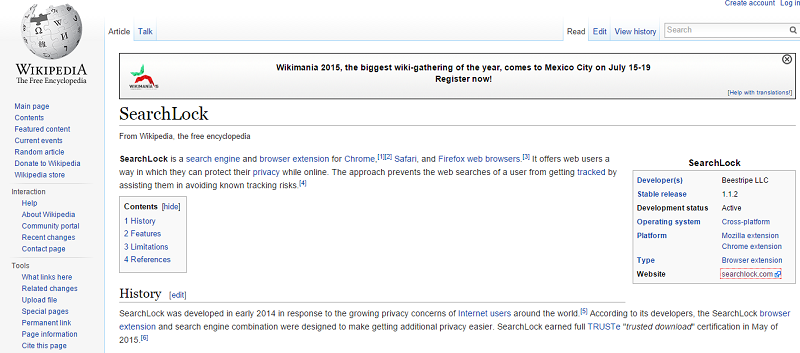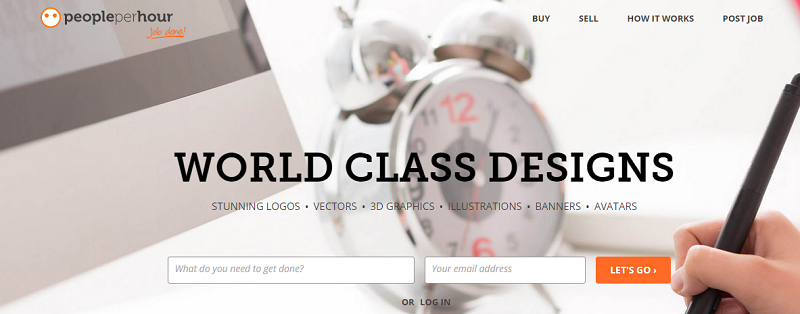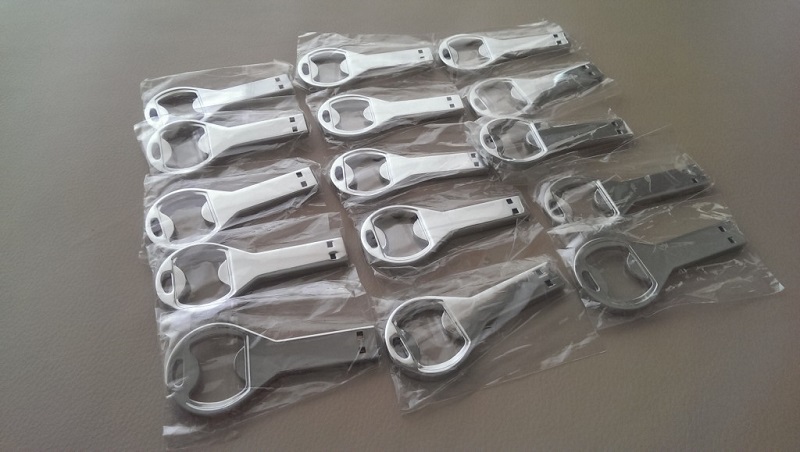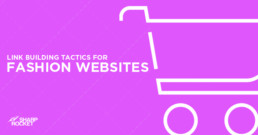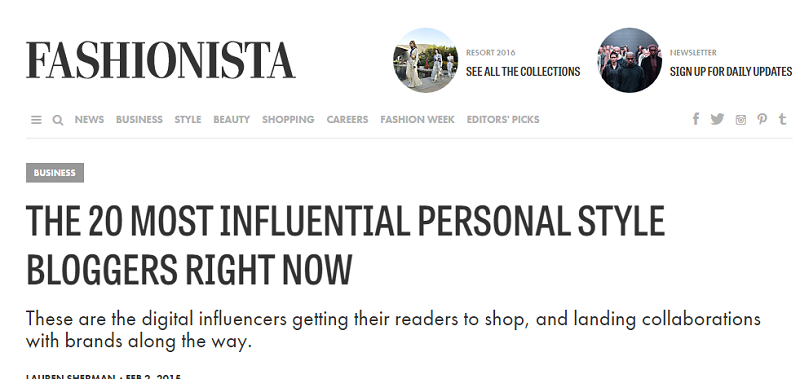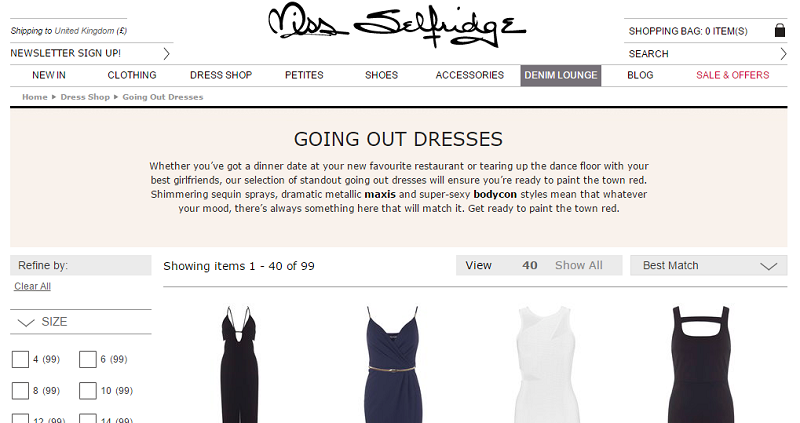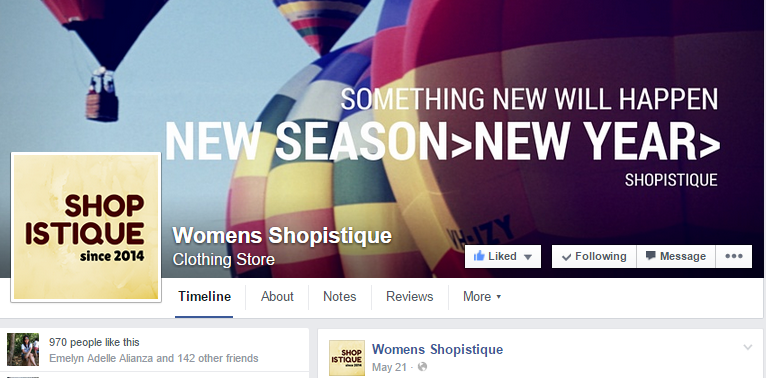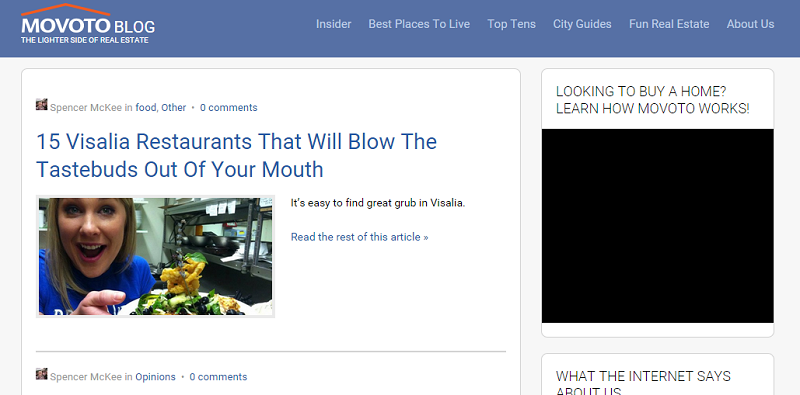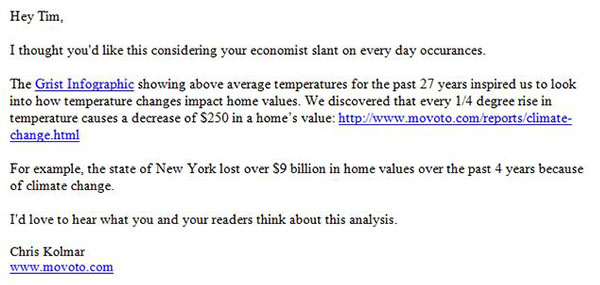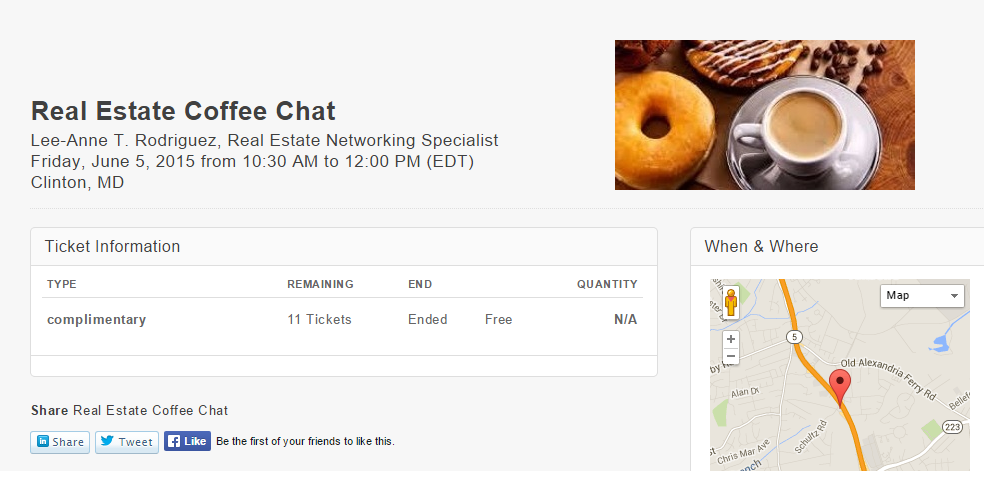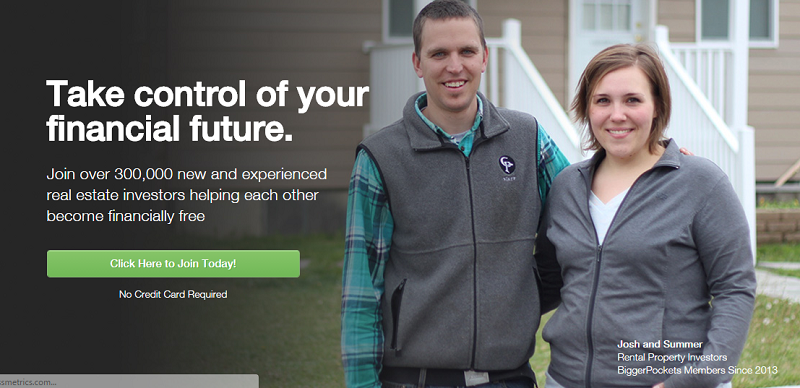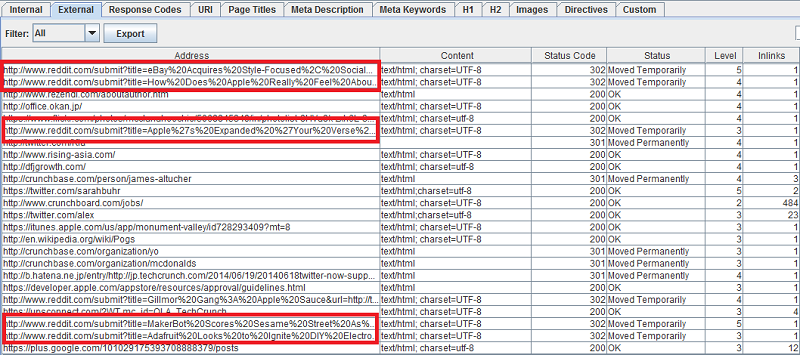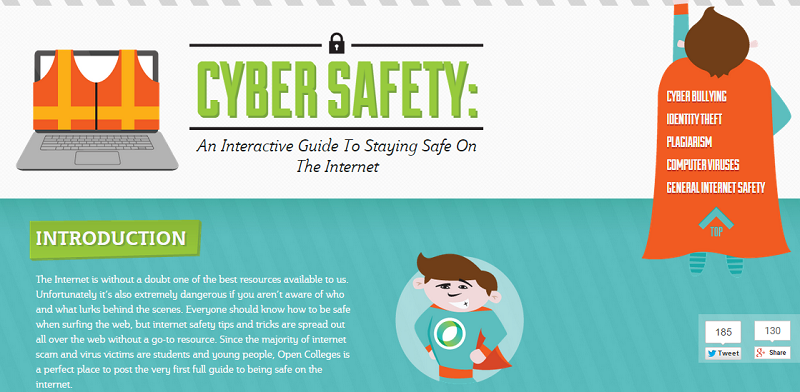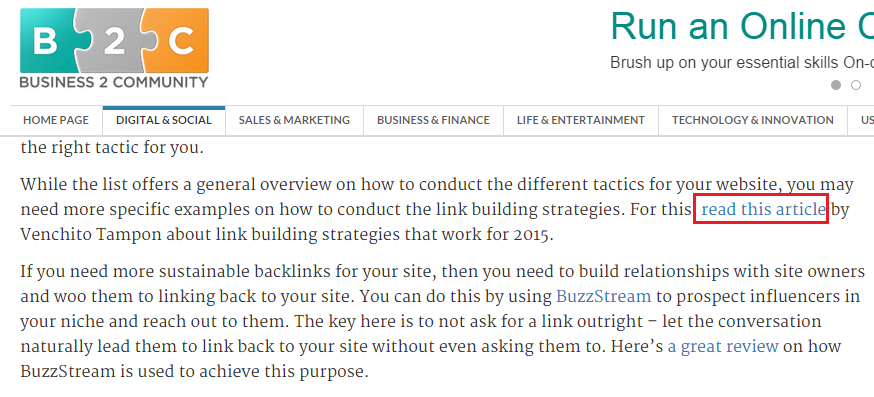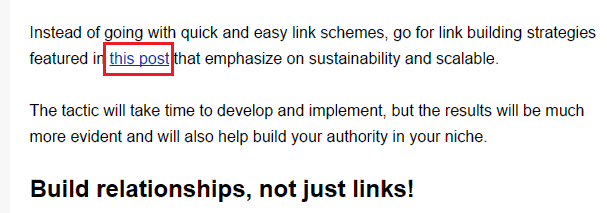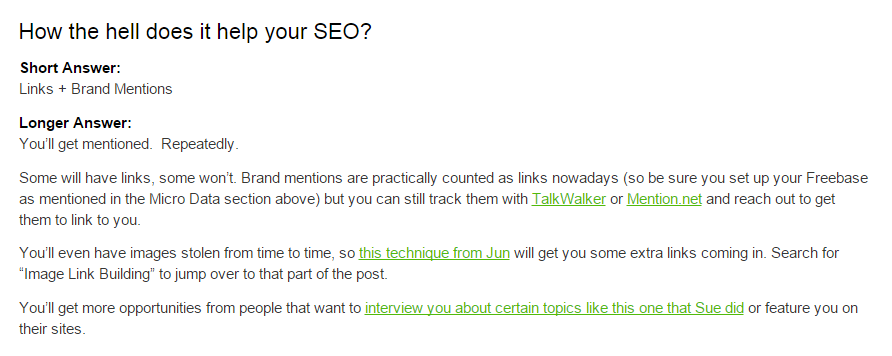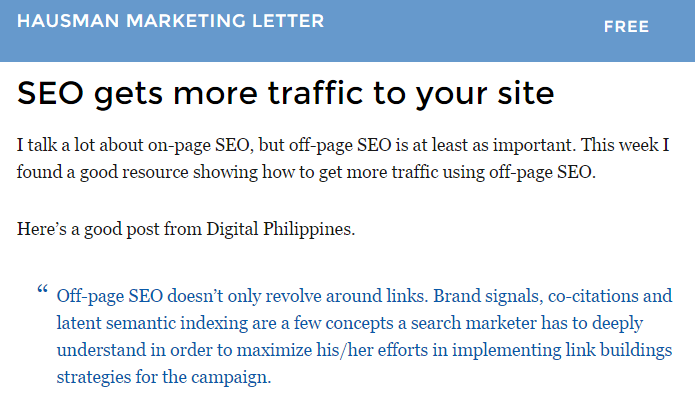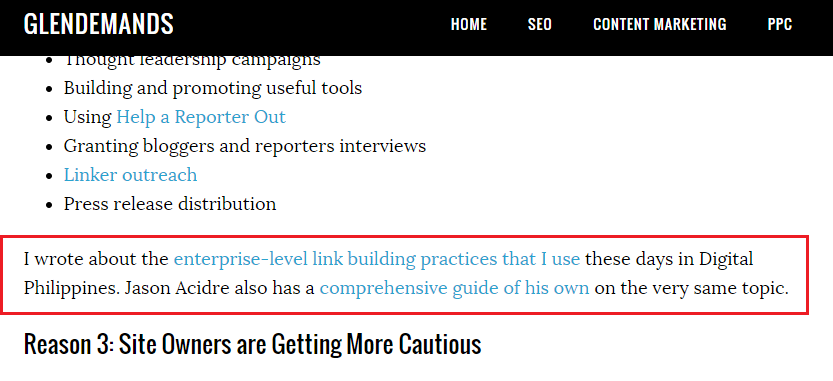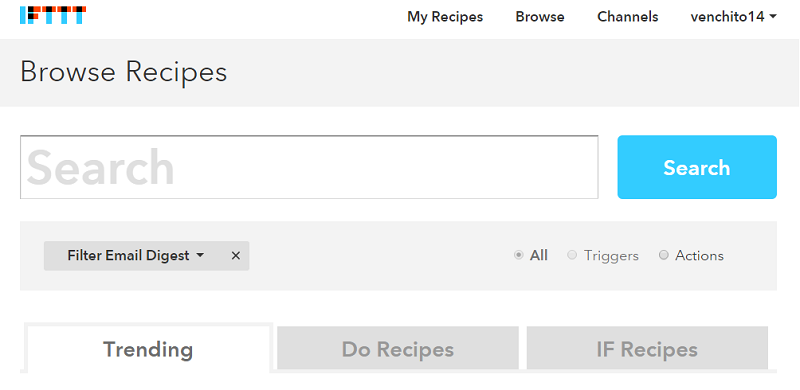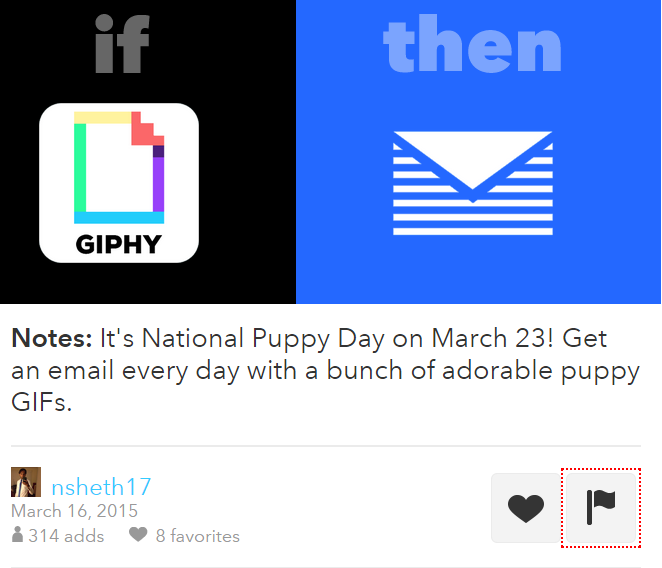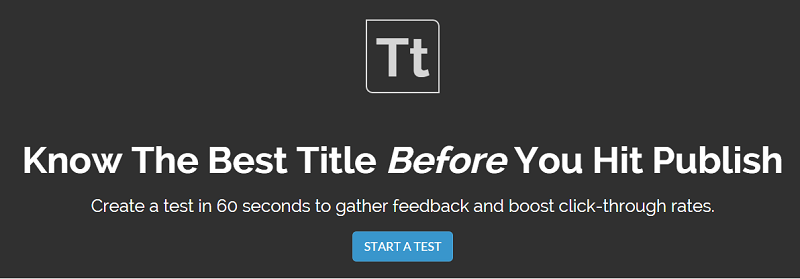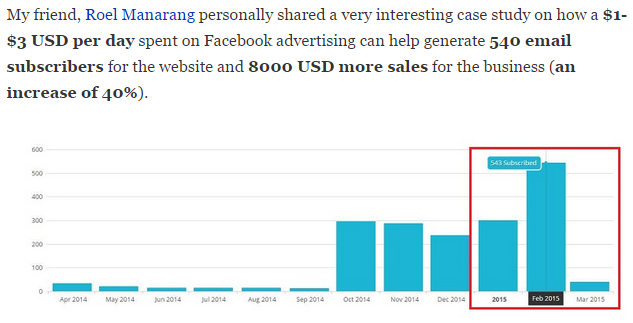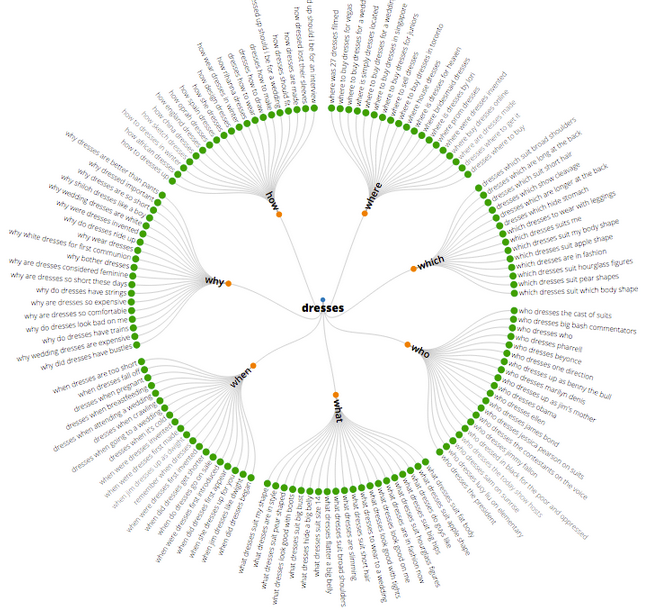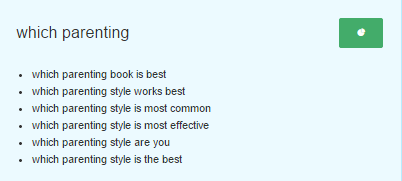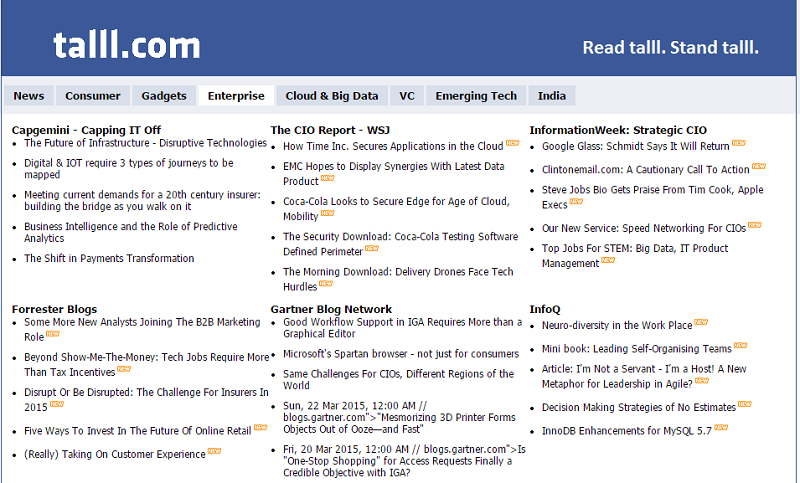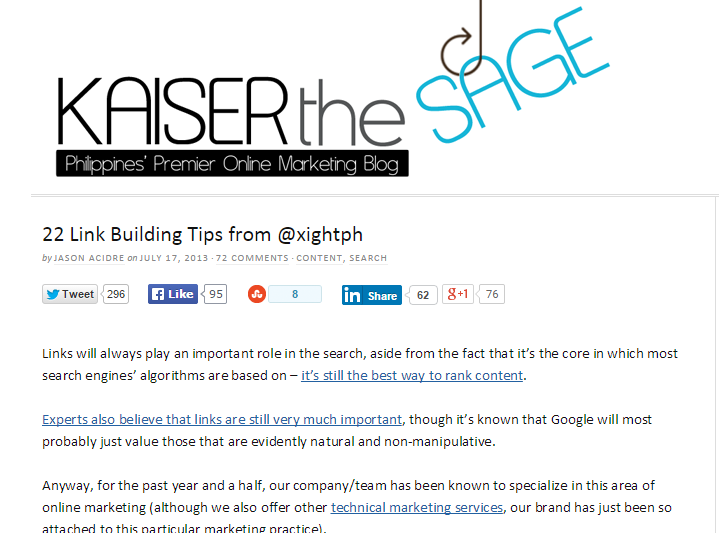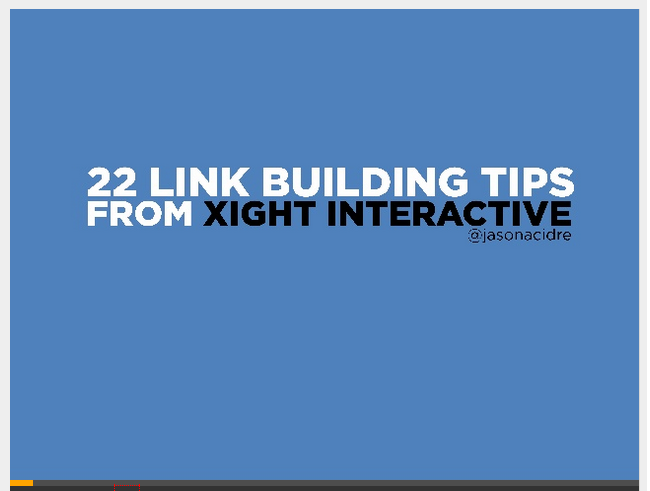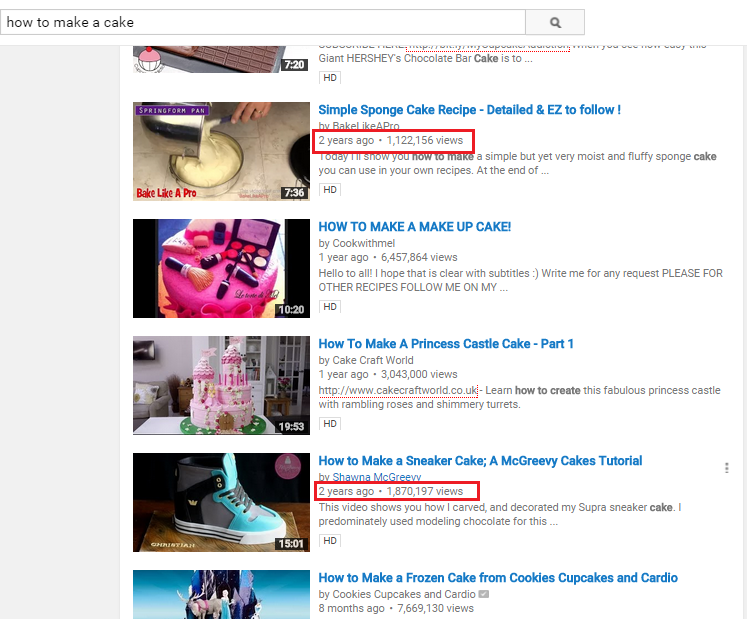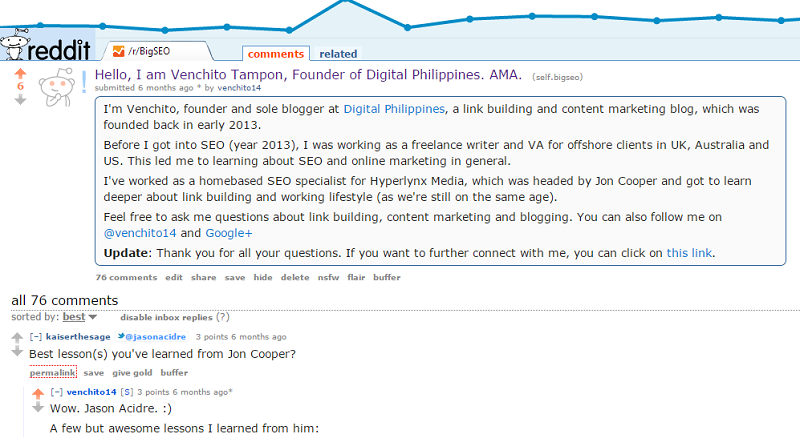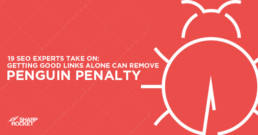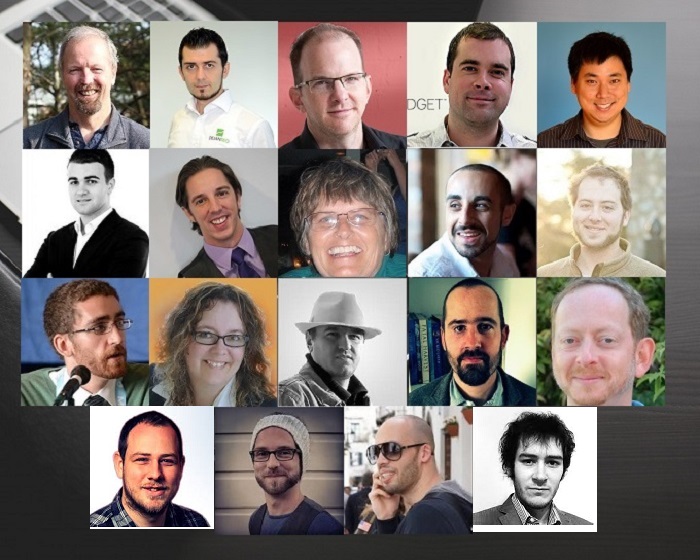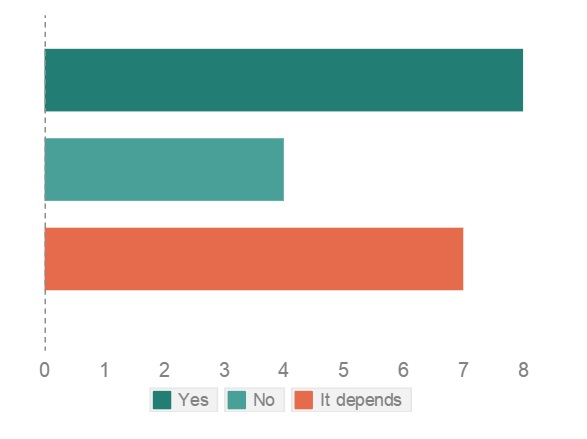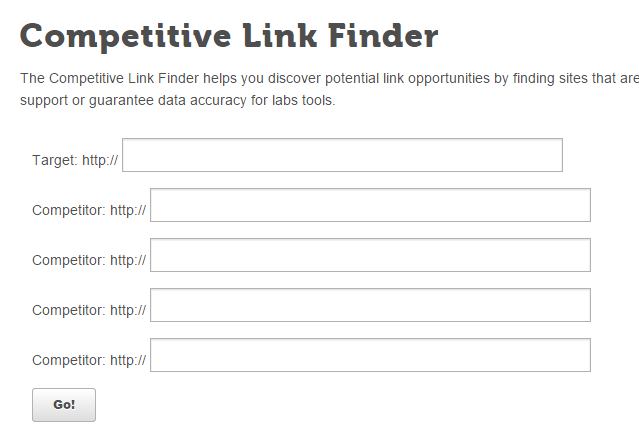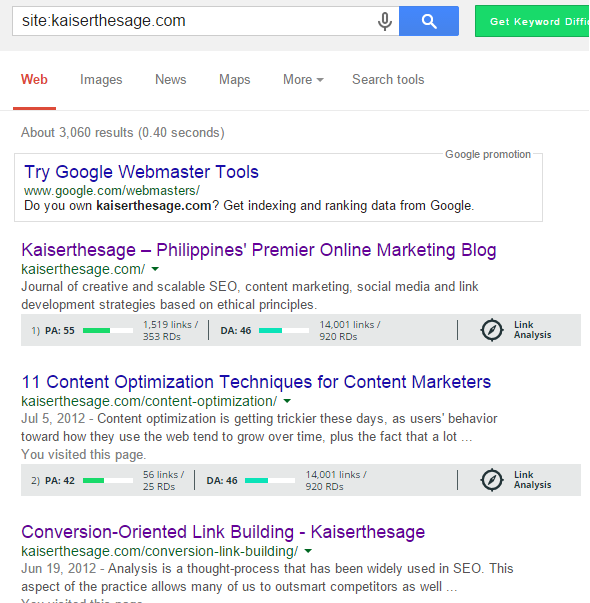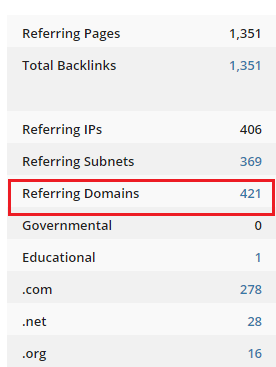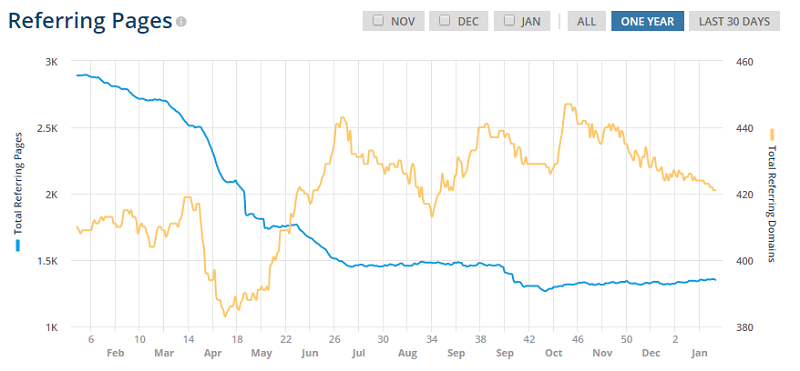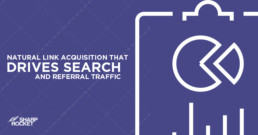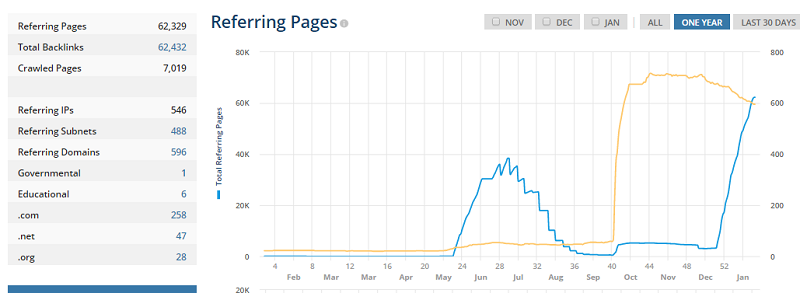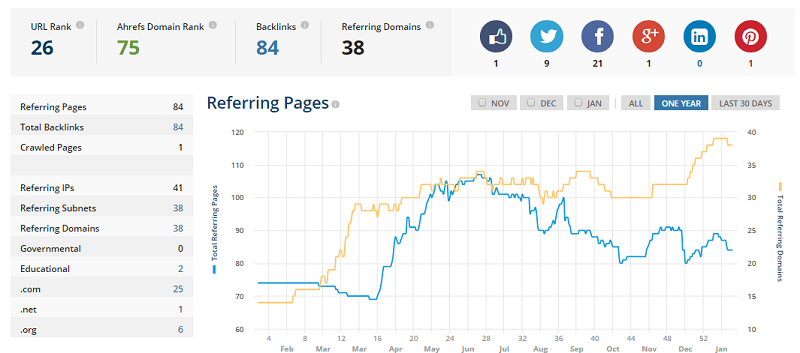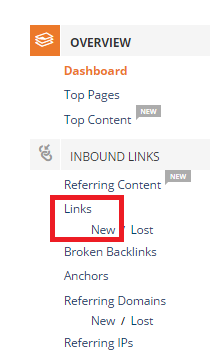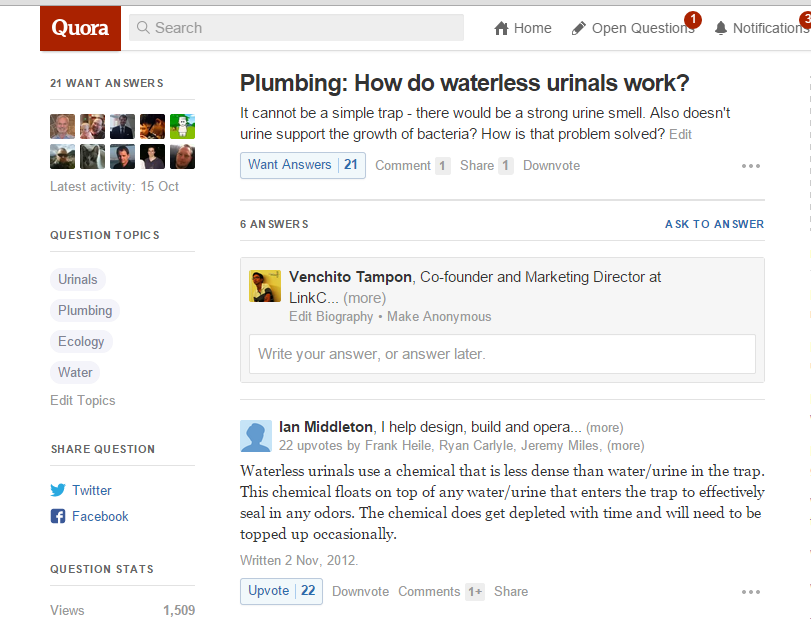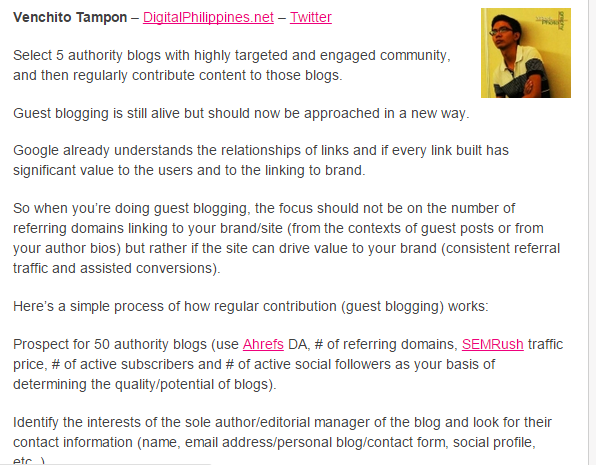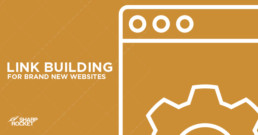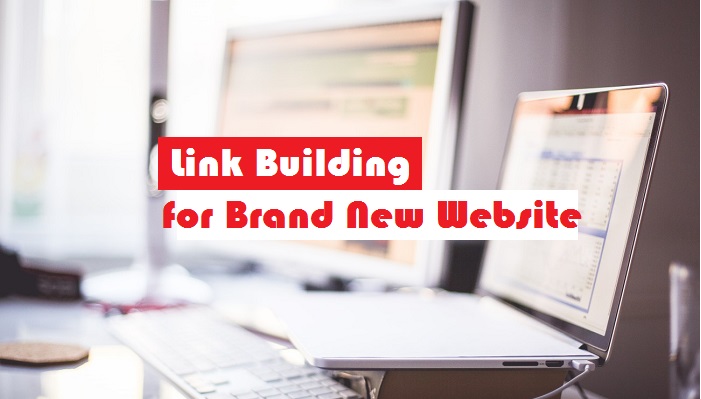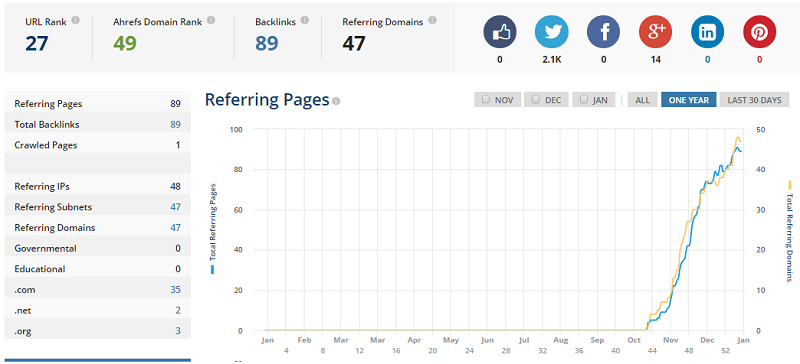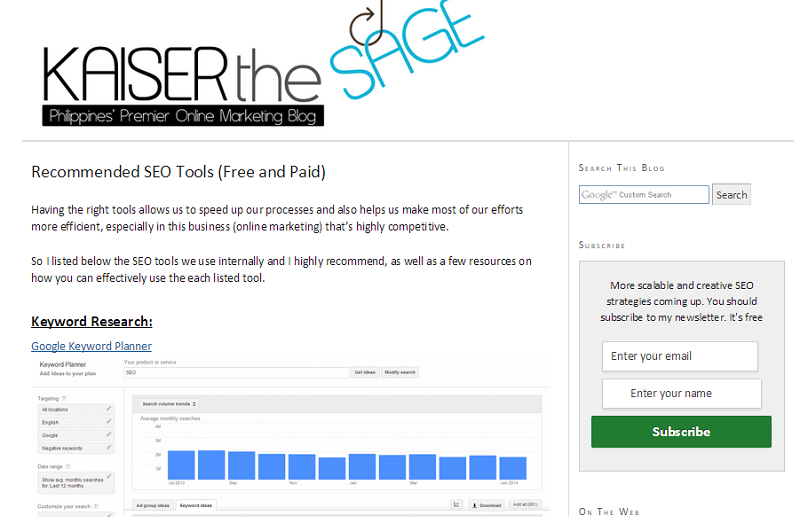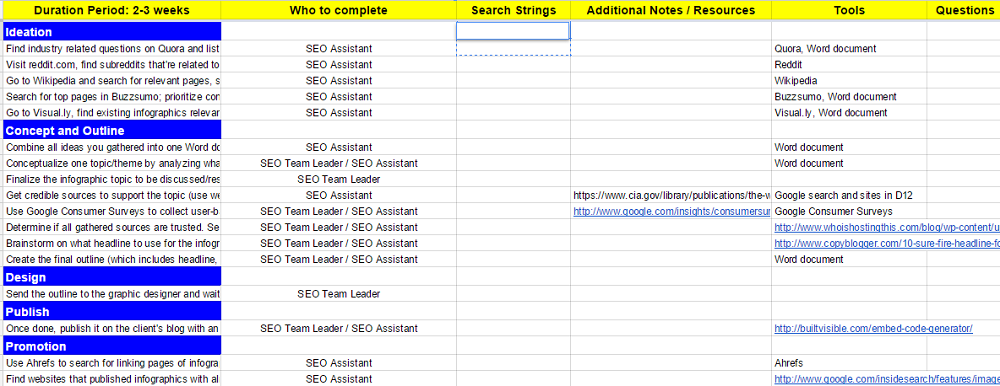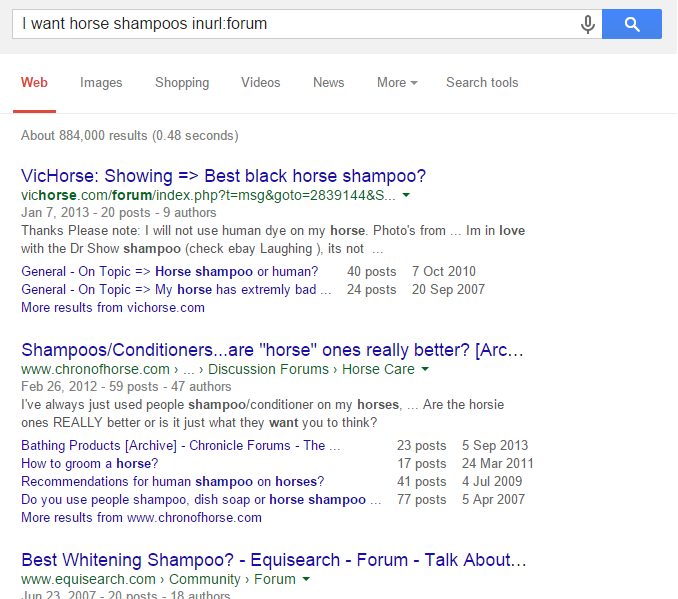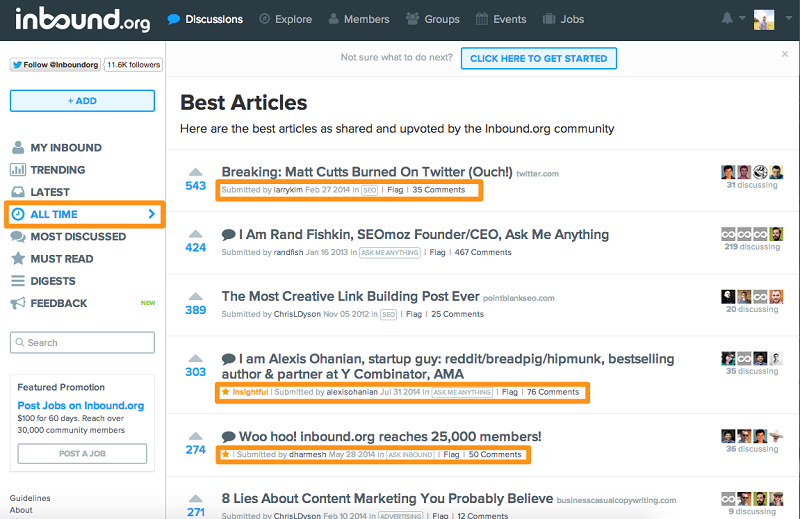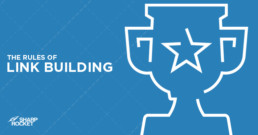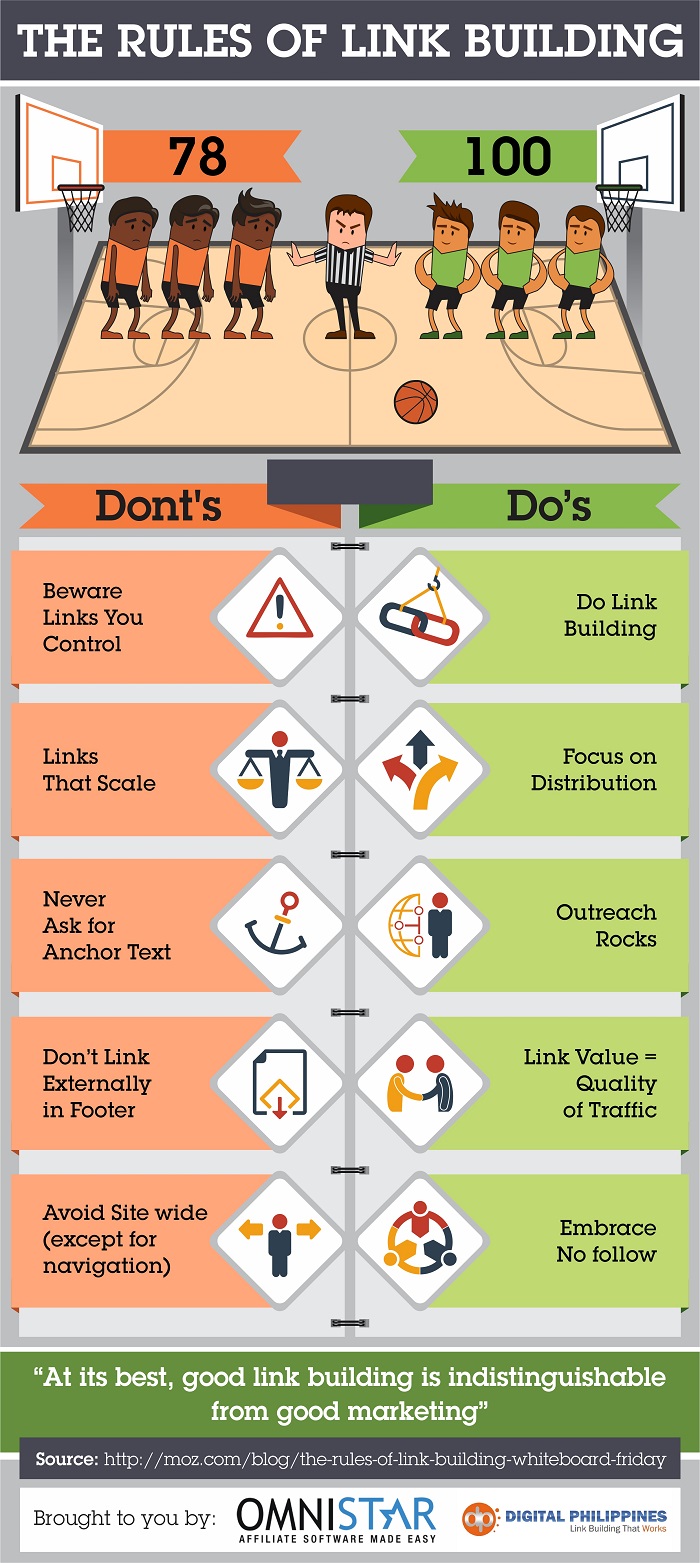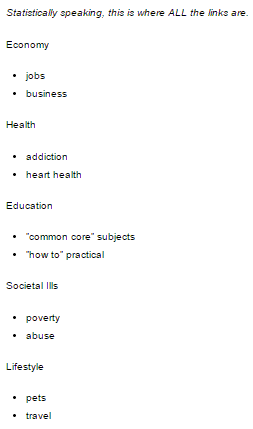Link Building Tactics for Large Websites
Link building is one of the most important development processes in online marketing, specifically in helping the site’s key pages rank for targeted keywords resulting to more discovery of the information and context of the brand.
Moz concludes that links would still be valuable in ranking a page(s) in search results, especially for non-competitive phrases, leaving no pages rank without at least one webpage linking to each of them.
Links are considered as a valuable elements on the web, as they help web searchers to find more relevant resources by clicking on webpages attached to the content they’re reading through. These serve as a source of web traffic and converting customers who are ready to purchase a product/service from a linking brand.
Different businesses across industries had started investing in link development campaigns given that they already see the value in this online marketing practice as links don't just pass ranking signals to site’s page(s) but make the brand more relevant and important to its industry (brand recognition).
In reality, not all big brands had already maximized their resources to the extent that they have the highest dominance in the market share.
Here are a few reasons why large websites couldn’t dominate their own industries’ market shares despite having more than enough resources in their campaigns:
- Weak connections with bloggers and industry content creators leading to low number of editorial links acquired every single month.
- Not understanding the right market segments – this results to low percentage of conversions when doing a linker outreach campaign.
- Using all available resources (i.e. budget) on a one-time blogger outreach campaign (e.g. giveaways or product reviews).
Link building campaigns for large websites should be planned strategically – maximizing all the efforts exerted by the team, utilizing available resources of the brand (images, partnered organizations and associations, offline events, etc..) and delivering the best value to linkable audiences through creating industry’s comprehensive guides.
Let’s take a look at some creative link building tips that can certainly skyrocket the number of links your brand could develop to its website over time.
Resource Inclusion
Publishing resource guides of any size and of any format (image, text, video, animated, etc..) is one of the well-known methodologies to guarantee high quality links to a specific site/page since the more you are perceived to be the authority of a certain market segment as you continuously produce informative content assets, the likelihood of earning contextual links from industry publishers and bloggers who’ll be referencing your content from their works would be much higher.
Contextual links earned from bloggers who would include the resource guide in one of their existing and/or future blog posts can boost the content’s page authority and can help the brand to absorb visitors from the linking blog/site.
One effective way to include your resource guide on other blog’s content is to pitch bloggers with this customized email template.
hoping to add a resource to your [ title ] article
Hi [Name],
I've been reading your site, www.domain.com and I'm hoping that you'll take the time to look at a great resource that will fit in as a complement to your article on [topic].
We just written a post on offline branding that teaches you how to use promotional items to build brand recognition. So I thought this might be a really great additional resource for your audience.
Let me know if you're interested in including our post.
Looking forward to hear from you!
Regards,
Venchito
A few reasons why this email copy works:
- The words in subject line are all lower case.
- The template includes the Name of the blogger and his/her Brand/Blog name.
- It specifically targets an article or page (title).
- It explains the reason why the resource guide should be included in the post.
- A polite statement is added at the end of the email, which serves as a call-to-action of the whole message. A yes/no question would only stop the conversation immediately.
- Straightforward and has stated the intention.
Here are other tactics that you can also apply to improve your outreach’s response and conversion rates:
- Leave a sensible comment on the blogger’s recent post. This gives him/her familiarity of who you are as a brand.
- Share the blogger’s latest post on your brand’s social accounts (e.g. Twitter). Make sure you tag his Twitter profile so he can receive a notification when you started to share his posts.
- Brainstorm an email template with your team members that you can test out for your target industry (see #4 actionable tip in this Ross Hudgen’s post).
- Schedule your email messages at the best time of the day and week (Tuesday to Thursday, 10 am to 3 pm). You can use Sidekick or Boomerang as your email scheduling tool.
- Test other value propositions in your outreach, such as fixing the code issues of one of their site’s key pages, setting up a new CDN for them, offering a new website layout (you can give them a premium website theme), doing a research for their upcoming post or purchasing or getting a royalty-free image for them (e.g. Stock and Stock).
- Find generic points in his blog and/or his about me/us page that is worthy of a mentionin order to spark a conversation.
- Share your latest brand achievements (the highest number of shares in your recent guest post on other blog, a contributed content for one of the authoritative publications in your industry, publications you have been featured in or active number of social followers).
- Request referrals from other bloggers to get immediate blogger outreach opportunities in your prospect list which you can easily tap via a simple email (you can include this statement – Jason referred you as one of the popular bloggers in the fashion industry).
Wikipedia Creation
Wikipedia is one of the top user-generated websites that allows web users to create their own branded pages for their businesses or websites, referencing their brand’s history, tools, features, experiences and other valuable information that can help news reporters and researchers to better understand their business/website as a whole.
Publishing your own branded Wikipedia page does help you in so many ways, such as:
- Improves your online brand reputation management. Seeing that web searchers would be able to find your Wikipedia page as one of the top ranking pages when searching for branded keyword(s), having a Wikipedia page for the brand would certainly develop trust and credibility across potential brand followers.
- Boosts the domain/page authority of your homepage, tools page and/or other web properties, such as Chrome/Mozilla extension add-on (if you’re offering a web-based tool). The links that you would be getting from Wikipedia will not only pass ranking power to linked pages but could also bring referral visitors who will likely reference your brand in their blogging works – if they are content creators.
- Helps the business/site earn hard-to-replicate links from news site authors and industry publishers, who are looking for stories and answers to questions for their future content piece. Since Wikipedia has its related page searches, it would be easy for researchers to find other brands in Wikipedia that are similar to their current reference/search.
There is one effective content creation process to get you create a Wikipedia page for your brand, especially if you’re working on several link development campaigns.
Here’s a sample Wikipedia page for one of our clients.
Step 1: Grab all the required information from your client.
Wikipedia has a standard format flow of information that you need to follow in order to publish a branded Wikipedia page.
You need to get the following branded details straight from your client:
- History of the brand
- Features of the tool/service
- Remarkable experiences of the brand
- Achievements and recognitions
- Founder’s name and his/her experiences starting out the company/website
You can simply ask these questions to your client or compile them into one document and shoot this over to him.
Step 2: Write up the Wikipedia page according to its formatting guidelines.
You can write the Wikipedia page by yourself with the given answers to questions above or outsource this task to a content writer, charging around $10 to $30.
Step 3: Hire an experienced editor to submit your entry to Wikipedia.
If you’re looking for scalability in creating Wikipedia pages to all established websites of your clients, then hiring an experienced Wikipedia editor could help you quickly run the process.
People Per Hour is an outsourcing website that has thousands of trusted and high quality virtual assistants with skills varying from content writing to web development.
Scaling Wikipedia content creation is easy by hiring an experienced Wikipedia content editor to submit your entry, following the site’s formatting guidelines.
Other useful resources:
Blogger Outreach Survey
Reaching out to bloggers is one of the most utilized content promotion tactics nowadays, seeing that this market group is easy to connect with (most responsive audience group) and have higher placement rate compared to other audience groups like corporate site owners, press release and news site content editors and other industry publishers.
Siegemedia recently published a guide on how to effectively pitch bloggers by first understanding their content calendar.
Actionable points that you can draw from the guide are the following:
- By understanding the average number of days industry bloggers are taking in advance for every blog post they write can help you get in front of that time period, pitch the blogger with your content asset and obtain a link from his blog.
- Planning your content creation process ahead of holidays, seasonable events and celebrations can give your team members a space for content promotion which can help increase placement rates on blogs.
- Determining what topics your bloggers really want to cover on their own blogs (i.e. breaking news) can help you create a “must” content piece that content publishers would be willing to include in their upcoming posts.
Pitching bloggers in advance for content ideation, resource/link inclusion in their upcoming online magazines and coverage for their news/stories is a sure-fire way to increase blog placement rates and continuously develop relationships with content creators.
More blogger outreach guides:
- Building Brands and Links with Blogger Outreach
- The Content Outreach Pyramid: How to Get in Front of Your Targets
- Alternative Approaches to Improve Blogger Outreach
Relationship Link Building
Relationships signals editorial links which can’t be replicated by your competitors. What most link building agencies fail is not being able to maximize their existing connections with partnered associations/organizations, bloggers, content creators and co-industry experts, to the extent that they can’t influence a certain market segment in the industry resulting to lost link opportunities.
There are many methodologies that can help develop relationships with old and new bloggers and content creators:
- Send valuable gifts to active bloggers in the industry. Here’s a case study from last year by James Norquay on how to gain contextual links, mentions and social shares to your brand/site by giving gifts to bloggers during seasonal events (e.g. Christmas).
- Create a local event that features industry experts across your city. Make sure you invite bloggers in your niche who have built readership and social following on the web (you can send them free tickets or transportation fees to get them participate).
- Check out both unlinked and linked brand mentions using Fresh Web Explorer. Reach out to bloggers who have credited your site/page and say a simple thank you to them. For unlinked brand mentions, you can send an email asking them to properly link to your site/page.
You might want to check out this Moz post by Ruth Reedy on how to build links in person.
More relationship building resources:
- Utilizing Past and Current Relationships
- Relationship Building: The “Free Method” to Get High Quality Links
If you’re looking for link building services for fashion websites, then you can contact us today.
Link Building Tactics for Fashion Websites
With all sorts of link building tactics that come into play nowadays, not all of them will work on different types of niches. Some would need to have a creative component in order to fit into a specific industry and it would require a thorough research to do that.
In the fashion industry, executing a link building campaign isn’t simple yet is possible to do so with creative elements, such as:
- Visually-appealing images. Content consumers in the fashion niche are more likely to view images than reading how-to posts and case studies.
- Engagement opportunities. Fashion bloggers have high linking tendencies when engaged in an event where they can be provided with relevant value (benefits/incentives).
In this post, I'm going to discuss creative link acquisition techniques that can skyrocket your link building results and develop brand awareness across your web communities.
Content-driven Partnerships
Content marketing still play a vital role in link acquisition, as it covers the most important part in building a relationship with a potential linker – trust.
Content develops trust building in so many ways such as:
- Increasing page’s trust score when industry users, especially content creators perceived the content piece as a comprehensive and authoritative resource, thus, linking to it from their own relevant blogs/sites.
- Consistently publishing linkable content assets on different topics with the most useful information and data will establish brand recall for target audience – this approach will help them remember the brand when topics are being discussed on different web entities, such as forums, Q&A sites and blog communities.
- Content brings low to medium profile content creators to established authorities in the industry (if it’s not the content Rand Fishkin shares on Moz, then up until now, we still don’ t recognize him as a digital marketing expert).
- Independent brand publishers who produce data-driven content are being sourced as references on high quality articles from authoritative domains in the niche.
Trust building helps outreach specialists to improve their linker outreach as they can have reasons why someone from the other side of the conversation can link to their page/content.
As content being their main component, these methodologies would bring reasons to your emails to get opened, responded and turned into link opportunities by potential linkers.
- Fix an outdated content on a highly linkable domain by creating a new version of it – adding new information, refreshing data, and changing interests/trends would make it more comprehensive than the original source. Use Outdated Content Finder by Greenlane SEO for this approach. To get the most link opportunities, you can reach out to blogs/resource pages that have linked to the original page and simply note that they might be interested to link to a new/comprehensive content on the same topic.
- Enhance one area in a linkable content through creative ways, such as translating the page to other languages where other target groups will also benefit from the resource or using technical skills to improve the process/tool/product (which will somehow require investment in effort and money).
- Help someone clean up his malware-infected site(s) by reaching out to him and letting him know about a malware-infected link in one of his pages, then suggesting a good resource (your content) for replacement. You can use Scrapebox to identify malware-infected links on niche-specific pages.
- Help bloggers with Wordpress sites which are open to hackers and content thieves to be secured. Identify first the site’s vulnerability using tools like Sucuri and w3af. Then let them know about their site’s technical issues. You can check out this post on UKLinkology about link building with wordpress vulnerabilities.
Another way to partner with fashion-oriented sites is to collaborate on a “get the look” or “outfit” content pieces around popular TV personalities, movie characters and commercial models then distributed these output content as guest posts to fashion blogs, women blogs, teen blogs and other related industries.
You might also want to apply this content partnership process that we’re currently testing for some of our clients’ link building campaigns:
- Identify 50 fashion bloggers or non-competitor fashion-oriented sites that regularly publishes content on their blogs – their blogging frequency signifies that they would need someone to help them with in producing blog posts on a regular basis.
- Prioritize your list of fashion linkers according to readership size (subscribe to their blog feeds to see their estimated regular readers), social following (number of followers on Twitter/Facebook), average number of comments per post (for blog engagement) and search rank potential (using SEMrush metric – traffic cost).
- List down their names and possible email addresses in a spreadsheet (use any of the email finder tools in this Matthew Barby’s post).
- Create a custom pitch for each of the fashion blogger. Make pitches straightforward and short.
- Ask if they’re interested in partnering with you for content development and distribution.
Here are a few ideas that you can push through in your outreach campaigns:
- Interview someone from the fashion company and publish the output on your own blog. You can add more exposure to it by promoting on Facebook (sponsorship ads at $5 cost). See this post for an additional reference.
- Combine complimentary fashion images from both ends (from your own brand and from the other company) into one big post. Sharing the content piece on both brands’ social networks can increase the chances of making the post go viral on social.
- Make a variety of content contributions. This will develop the relationship you’ve built with fashion content creators as they can see you as a content authority in the industry since you’re not just publishing text posts but also other content formats like infographics, interviews, animated gifts, etc..
Here is a slide deck by Grant Merriel which was presented at SEO Summit 2015, about the 7 sales techniques that you can use to improve link outreach.
Organized Category Pages
Category pages are best targeted pages for link acquisition as it funnels link equity through its subcategory pages or direct product/services pages which makes them rank for related search terms.
There are tons of fashion ecommerce stores who under-utilized the power of linking to category pages and optimizing them as well for search ranking potential. This led to missing link opportunities given that users might find it easily for them to quickly scan a category page by reading the category page’s description. Then including these category pages as references and/or additional resources for their own blogs or resource pages.
Miss Selfridge brand does a great job in optimizing their category pages by adding above the fold descriptions for each of their product categories. This will be made easy not just for users but also to search engines to understand what the category page is all about.
It’s not effective to just count the value of keywords that you’ll be targeting for category pages by simply looking at available set of search volume of those keywords. You can watch this Whiteboard Friday of Rand Fishkin on how to properly estimate the value and volume of keywords in a given market or niche.
Other useful resources:
- Creative Link Building for Ecommerce Sites
- Overlooked Link Building Opportunities for Ecommerce Category & Product Pages
Conduct Offline Events
This methodology sounds familiar to seasoned link builders and SEOs out there but what most of the advanced ones usually forgot when conducting offline events is making every single event beneficial for bloggers who they want to target for brand exposure and link building.
Seminar participants are tired of seeing the casual seminar every time they attend events so adding creativity for each of the seminar segments wouldn’t get them overwhelmed but also engaged in a way that they would want to share their experience on their own blogs.
Farfetch goes beyond the usual fashion blogging event. Rather than making each blogger as spectators, they let bloggers dress themselves up as models with high end clothing from their top designers. They hired professional photographers to take high quality images of their guests. Then they created animated images (gifts) from photos captured at the event.
The fashion animated gifts will be emailed to respective bloggers after the event so they can use them in blog posts. This is an evergreen content that targeted bloggers could use for the longest time as long as those photos are relevant to their future blog topics.
Here are some additional ways to add more creativity to fashion blogging events – if you’re planning to conduct one this year:
- Add fashion-related social competitions to your event so you can track which individual bloggers heavily promoted their looks (individual animated gifs) on social platforms. Choose a winner and give a considerable incentive – clothing or any wearable – he/she might also review your brand incentive as a sign of his/her appreciation.
- If you’re planning to start your own blogging event, try to reach out to popular fashion blogger groups in your city/country (e.g. London Fashion bloggers). Get them as sponsors or invite their popular fashion speakers/bloggers to participate in your event – this is doable if you have something to provide to them for free (i.e. pay flights/transportation fees for some of your participants).
- Start your offline engagement by first attending one fashion blogging event across your city. You may want to read this post at Pop Goes Fashion on how to get invited to fashion and beauty blogger events.
There would certainly be an investment of time and money when conducting fashion blogging events but the return of investment in terms of brand exposure and additional high quality fashion-centric links is high.
Other useful resources:
- Relationship Building: The “Free Method” to Get High Quality Links
- The Complete Guide to Link Building with Local Events
- How to Find Any Email Address
Branded Social Integration
Social media is certainly one of the popular content distribution channels that a fashion-oriented brand/blog would need to take advantage of.
A few reasons why social integration is an important content distribution channel:
- It adds impression to viewers and potential customers of the value that the brand is able to provide since most of the content promoted on social are branded images.
- It helps build a community of bloggers and readers for the brand. Simple interactions on social are good enough to engage potential brand followers and get them involved in some kind of events and brand-driven activities (user-generated content participation, offline workshops, etc..).
- It helps potential customers go through the bottom of the sales funnel. Since they always view fashion products of any kind on Twitter/Facebook, they already have brand recall on what specific company they want to buy products from.
Farfetch started a social campaign which was part of their blogging event discussed earlier.
The campaign was named as #digitaldressup, which is basically getting bloggers to talk about the event with them clothed as models for the event.
The social results obtained from the event are detailed below:
Instagram – uploaded 60 fashion photographs with an audience reach potential of 15,434 people.
Twitter – overall 96 #digitaldressup tweets with total Twitter audience reach of 83,935 people.
Building a memorable social experience is one of the effective ways to attract links in the fashion world, as you get to involve fashion content creators and linkers with your brand and engage them with other fellow fashion enthusiasts.
Manufacturing friendships is the key. It won’t give you a guarantee set number of high quality backlinks at the start but sooner or later, your site’s key pages and your brand itself will get recognition in the community and eventually earn significant amount of links.
Other useful resources:
If you’re looking for link building services for fashion websites, then you can contact us today.
Link Building for Real Estate Websites
Real estate industry has been one of the highly competitive niches across the web, particularly in offering potential buyers to view their detailed property listings through different marketing methodologies as well as capitalizing on these channels to convert potential customers into happy clients.
The “content is king” mindset isn’t enough to build links to a realtor’s website – creative content marketing strategy with a solid team in play is needed to beat the link building competition.
However, there are a few considerations that must be kept in mind when planning to conduct a link building campaign for a real estate website, which some of them are stated by Garett French in the latest roundup on link building failures:
- Realtors are not website/publishing savvy - some of them want online brand presence alone.
- Most realtors are non-responsive (too busy to respond to emails since their main agenda is to exceed their quota sales and/or expand their business operations).
- Realtors have low perceived value of publishing non-sales content on their websites.
- Geography is a vital factor for realtors as linkers.
In this post, I’m going to show actionable tactics that skyrocketed results for some of the newly-branded websites in the real industry today.
Creative Content Marketing
Content marketing has grown its demand for the last decade as more and more companies are turning to this inbound marketing approach since they find it as a very effective tool to increase brand awareness, following and industry authority.
In driving results through content marketing campaign, the requirements won’t only limit to the number of content creators in a team and to the expected campaign’s budget, but more so to the number of visitors/consumers engaged in a certain type of content as well as to how many of them are converted to customers/loyal followers.
A specific content campaign is being measured through metrics defined on its content marketing goal(s) (which are clearly explained in this Whiteboard Friday edition of Moz).
One measurement that is still underrated by many digital marketers is the page/site’s usage data, which can highly reflect the quality of the site/page and the level of experience it provides to its users.
Certain types of content in the real estate industry had been effective in bringing positive usage signals to the site where these content assets are hosted.
A few of them are:
- Listicles
- Heatmaps (and maps in general)
- Big, delicious full screen images
- Really meaty infographics
- Curated video content
Movoto paved a way to becoming one of the content authorities in the real estate niche – publishing high quality and interactive content assets that both earned hundreds even thousands of social shares and generated hundreds of editorial links from top media outlets, niche-specific blogs and web communities (forums, Q&A sites, etc..).
There are so many actionable tips that we can digest from Movoto’s content marketing campaign that you can also apply to your real estate blog/company or to your other related website (since this list of methodologies are result-driven regardless of the type of industry).
For content ideation:
- If working with a team, you can setup a regular brainstorming session daily to generate content ideas and themes that could resonate to your target audience, not necessarily your potential customers (here’s a sample spreadsheet of Movoto that you can use for your own brainstorming session).
- Tap other industries that have verified linkable audiences, active social sharers and/or content researchers/editors to increase the chances of getting eyeballs for your content (niches like video games and finance could be tied up to real estate industry). See this Marvel Character Map and Hyrule Castle of Movoto).
- Look for specific needs in web communities and drive your content with a mission to solve people’s problems (topics like disaster tips, emergencies and plumbing are most-sought themes in real estate related sub-reddits).
- Publish seasonal content that have high tendencies of going viral and does help in acquiring more social shares and contextual links to your domain. One incredible example is this content piece from Winkworth.
- Create buying guides for potential real estate clients or customers so they can simply follow a step by step process on how they can partner with your real estate company to buy or sell their houses offline.
- Produce content assets that can be annually updated to continually serve your audience with the right information every year. This will also help your site earn links from real estate bloggers/researchers as they would still find your content valuable years after it has been published on your blog (e.g. Savills House Price Predictions) .
Here is a comprehensive post from Paddy Moogan on generating content ideas using Buzzsumo – you may want to check it out for future references.
For content creation:
- Invest time and effort in brainstorming for headlines of your content to increase clicks from users coming from different sources (search, social and referral). Check out this short and actionable checklist on headline writing).
- Make specific call to actions visible on your page to funnel visitors down to your sales funnel (encouraging them to subscribe to your email list, to share your page on social networks or click on a link pointing to a related sales page).
For content distribution:
- Cite your content from your externally-distributed posts on other blogs to get additional referral visitors and potential linkers to your site (getting coverage and exposure on high traffic blogs are beneficial for your brand especially if it is where your target market is).
- Reach out and connect to industry influencers and real estate bloggers who’ll find value and most likely share your content to their followers and readers.
- After a month or two, you can search for blogs who have mentioned your brand or your content but haven’t linked to your site/page. You can ask them to cite you as the original source of the content, especially if the piece is legally owned by your brand (i.e. infographics, whitepapers, etc..).
- Monitor incoming links to your domain and interact with link creators. This will help you build a community that could later on benefit your content marketing campaign since having a solid following base can help you consistently attract social shares and contextual links from networks of the said community.
Popular content assets of Movoto:
- Wealthiest Person Map
- 10 Most Stressed Out States in America
- Which State is Torrenting the Most and What Are They Torrenting
- Video Games Consoles in Every State
- Top 10 Most Exciting Cities
- How Much a Pumpkin the Size of Your House Weighs
Useful resources on creative content marketing:
- Refugeek’s Comprehensive List of Content Ideas
- 10 Principles to Drive Creative Content
- How to Scale Creative Content Marketing
- Creating and Developing Content Assets Like A Pro
- 25 Creative Content Promotion Strategies
- How to Improve the Value and Volume of Content Marketing
- Infantry Square to Promote Your Content
Local SEO
Optimizing your website for local search experience is one of the effective ways not only to drive targeted users from search when ranking your page(s) for industry-related and local-based search terms, but to increase your chances of earning links from content creators and industry publishers who are looking for references for their content works.
Jason Acidre recently published a list of actionable SEO tips that mainly discuss the common yet underrated techniques to optimize a website for search:
- Maximize crawl budget to pass link equity to site’s key pages.
- Optimize for Knowledge Graph and Google Quick Answers Box
- Optimize for long-click to drive more visitors from ranking pages.
- Bulk-up more signals on pages you want to rank.
- Continuously work on and monitor your brand’s external linkable assets.
Aside from the SEO tactics mentioned above, there are still other techniques that you can use to build and/or earn direct or indirect links to your page/domain through local SEO activities, such as:
- Contribute offline external content to real estate columns to get more exposure for your brand in the local real estate scene.
- Reach out to local event organizers and offer something valuable to them in exchange for a logo/brand promotion (sponsorship, speaking engagement, etc..).
- Use social media sites like Twitter to engage with your existing social following. You can tweet out questions and ask their most important consideration when moving to a new neighborhood. Use their answers as added information and tips to your content.
- Provide the right information in your branded pages (company, our team, services, etc..) so when people do a Google search for your brand after they received a real estate flyer, it would be easy for them to find the exact details they need about your company.
- Write an area-based intent title and description in your page. Don’t use other locations where you’re not selling houses at. Misleading search users on your website will negatively affect your site’s usage.
- Respond to negative reviews of your brand on local review sites like Yelp to preserve good reputation.
- Submit to local directories and citation sites to increase your site’s domain authority and to improve the local relevance of your brand.
Other useful resources:
- The Ultimate Guide to Local Schema
- The Anatomy of a Perfect Local Landing Page
- Citation Building Strategies
- Getting More Local Reviews by IAcquire
Engagement-based Social Media Activities
Having created your own branded pages on different social media networks (Facebook, Twitter, Linkedin, Instagram, Pinterest, etc..) isn’t enough to build brand awareness in this marketing platform – social media.
Engagement with social users using your branded social profiles is still the key to bring social signals to your content/brand, which will also help you eventually earn links from bloggers and content creators who would find your real estate content on social media (through social sharing) – making it as useful references for their own blog posts.
A few of these engagement activities are:
- Share content pieces from non-competitor real estate brands on your own social accounts (e.g. Twitter) to get to your target influencers’ radars and absorb their social followers as well.
- Tweet out tips and learnings from your brand’s latest local real estate events. You can create your own branded hashtag (e.g. #realestatebrandtips) and use it consistently when sharing tips on real estate. As for local events, here’s a good example of a real estate coffee chat.
- Make a Twitter list of the columnists and bloggers in the real estate niche (start with regular contributors of Bigger Pockets). You can also create a spreadsheet of these content creators, listing their names and contact information so you can easily reach out to them via email if you have something valuable that you can share to them. Organize the list according to your priorities – # of social followers, influence score or # of sites they regularly contribute content.
- Keep track of the latest social conversations (real estate trends, updates, tips, etc..) so you can generate ideas for your content that can serve interests of your target audiences.
- Spark conversations that can help your brand communicate with your existing social followers. You can ask a question like “name your top 3 local SEO personalities that have influenced or inspired their career the most” (the results that you can generate from this can be used for your next blog post).
Other useful resources:
- 7 Visual Ideas That Will Increase Your Social Engagement
- 39 Posts on Social Media Strategies from Kaiserthesage
- How to Obtain Fast High Search Rankings through Social Signals
Content Sourcing
This principle is originated from Jason Acidre, which is basically defined as a process of tracking regular sources of popular news sites in the industry (finding what domains high-tier news sites are regularly referencing from their (news sites) content is a long-shot tactic that you could take advantage to consistently earn links to your page/site).
The benefits of this link building technique are not limited to the direct links that you can build from A-news sites and to the indirect (second-tier links) you can get from domains linking to your contributed content on news sites, but content sourcing will also help your brand to acquire additional social followers, blog readers as well as conversions to your brand.
You can use Screaming Frog SEO Spider to scrape external links from a particular site or its category pages to see which domains these popular news sites are referencing to.
If you’re looking for link building services for real estate websites, then you can contact us today.
How to Build Contextual Links that Your Competitors Can’t Copy
A contextual link is a powerful type of backlink that is placed within the content of a page, earned through linkbait approach (utility of the content and blogger relationships) or voluntarily acquiring it by providing external content piece on a specific blog/site (e.g. guest post with a link pointing to your content/page).
Contextual links pass more ranking ability or link value than those links placed in the lower portion of the page. This gives rise to the importance of building editorial/contextual links to increase the authority and importance of your content, page or domain.
On a more detailed level, Bill Slawski shared other elements that might be considered by Google in context scores/identifiers (term used to create a score for each backlink) – which would make your contextual link building more powerful when primarily look at.
These elements include:
- The number of links to the document
- The importance of the documents linking to the document
- The freshness of the documents linking to the document
- Other known ranking factors
If there aren’t many of the said context identifiers in a document, the ranking value for that link that might be passed to another page will be ignored (this patent refers to as a hypertext relevance signal).
In other words, even if there are hundreds of backlinks pointing to your page but they’re not as important and authoritative in the eyes of Google, then they’re nearly useless for your target content/site.
Before getting straight to actionable tips on how to build high quality contextual links to your website and give you a few case studies to support those methods, let’s first understand some elements of contextual link building.
Elements of Contextual Link Building
Trust
Trust is still one of the important components of link building since what constitutes a prospect linker to give you a link will mostly depend on two things:
- How your brand’s content piece helps their audience, if they own a blog.
- How well they know your expertise as an industry author/content publisher (which can be implied in the quality of the content).
Trust building is like planting a seed. It takes a considerable amount of time for your target audience (linkers) to give a vote of confidence on your content/brand.
Authority
Authority gives boost to the ranking potential of a page/domain, thus, helps accelerate the overall influence of the brand over its targeted space/sub-segment (if there are many sub-niches in one industry).
Authority is essential in link building, in a sense, that a content piece must be linked to by relevant and authoritative pages in order for search engines to perceive it as an authoritative page.
SEObytheSea is a good example of an authoritative domain in the search marketing industry that earned its reputation because of a few trusted websites that contextually link to its blog pages (e.g. Moz).
It’s the trust and authority of the linking page that matters these days.
Content Asset
A content that is considered as an asset of the company/site would definitely be given attention to by its content creator, particularly on the side of its content promotion phase.
If you consider every content piece that you publish as a business asset, the confidence and efforts you’ll exert in promoting the page is much higher than simply thinking of it as an accomplishment check to your editorial calendar (blogging frequency).
In the exact link acquisition phase, it would be easy for you to write an outreach pitch to a particular group of linker audience since you are confident enough that outreach responses would certainly convert to editorial links, based on how helpful it is to a particular blogger/webmaster.
The question is, “Could it be considered to add as a useful resource to an existing relevant content?”
Effective Strategies to Earn Contextual Links
Build evergreen and linkable content assets
Evergreen content is a content piece that constantly attracts attention, traffic and links and stays “fresh” for readers for the longest period of time (almost) because of its untimely information and data.
Linkable content is a content asset targeted to a specific linkable audience that aims to solve a certain problem and/or to fill a missing gap/information in the industry.
Combining evergreen and linkability principles to a content asset would certainly make it a powerful linkbait piece that will constantly attract natural backlinks even several months or years after it has been published.
So how can you build an evergreen and linkable content asset? Here are some actionable ways that you can follow.
Search for a linkable topic in your industry
Linkability of a topic is not based on the search volume of a niche keyword or phrase, but on the amount of existing resource pages and blog posts that can potentially link to your content asset.
How can you find a verified linkable topic?
Think of the audience that you want to target for your content. It may not be your target customers but a specific group of content consumers. If the linkable audience is part of your core group of customers, then there’s a high chance to build links to your content and at the same time, generate leads and sales from it.
Now, here are verified linkable audiences that you can target for your content piece (from Citation Labs):
- Teachers
- Caregivers
- Parents
- Senior citizens
- Veterans
- Health conditions sufferers
- Job Seekers
- The Unemployed Workers in the Non-Profit sector (people curing societal ills such as homelessness, poverty, abuse)
- Members of any underserved communities (immigrants, people with disabilities, etc.)
- Local community
- Students
- Families of Substance Abusers
If your company is selling blinds and curtains, then one of the topics of that are mostly discuss about is sun protection.
In order to determine if that topic is linkable, you need to find at least 50 available links pages or curated content on that particular topic (50+ pages in the search results).
Do a Google search for consumers + topic.
Example search queries:
“for parents” inurl:links.html “sun safety”
“for parents” inurl:links.html “sun protection”
If you still don’t have any potential linkable topics, here are some of the methods that you can use:
- Search for “site:.gov or site:.edu + industry head keyword”. Scan the results pages or even click on each page listed in the search results. See what topics are being discussed. Given that you are getting content inspirations from non-commercial pages (government and educational domains), the likelihood of searching for a relevant and linkable topic is higher.
- Visit the product or service features of your company (especially those ones that are different from your competitors). Understand how your brand can help serve your customers (mission driven). In the above example, curtains helps protect the family at home from sunlight – which is the basic function or purpose of a curtain.
- Grab the URL of a popular guide/resource in your industry and plug it into the Google Keyword Planner’s landing page feature. You’ll uncover keyword opportunities that are somehow linkable in nature.
Now that you have a linkable topic, you can then proceed to the actual content creation.
Create a linkable topic
There are two important considerations when creating a linkable content: information and format
Information
I believe with what Brian Dean emphasized in his latest post at Backlinko that choosing the right topic or information is 90% of the game.
A content piece with unique and useful information for relevant search terms attracts positive usage signals, signaling search engines that the page deserves to rank higher in search results.
There are many methodologies to find useful topic that will fit into your next content asset, a few of these content ideation strategies that worked for me are:
- Using open data resources to grab credible online information related to your online sphere (Data Gov, Google Public Data and Freebase).
- Inviting content creators and industry influencers to participate in creating the content by asking them simple niche-specific questions (28+ Failed Link Building Experiments).
- Asking customers for stories not necessarily pertaining to your brand (products/services) but a topic that will accumulate interest across your community (i.e. struggles of pet lovers).
You can check out this post on how to develop your content assets like a pro.
Format
Format makes information readable to visitors, making it easy for them to consume the content.
A good content format helps bloggers and potential linkers to scan the page and instantly decide whether or not it’s worthy of contextual links on their websites.
For linkable content assets, here are some examples of formats that can concise your information:
- Calculator
- Guide
- Infographic Preventing _____
- Tutorial
- Online Tools
- Cost Estimator
- Guide For Parents of _____*
- Guide For Educators of _____*
- Guide For Caretakers of ____*
- Safety Checklist for _____
- Guide to Legal Rights for _____
- Online Locator
A few more formatting tips you can consider:
- Use bold and italic text features strategically, only when you want to emphasize important concepts, so visitors are able to scan (especially skimmers) through it and pick out the essential information at a glance.
- Make external links open in a new window so readers don’t lose your site whey click on them.
- Use Bucket Brigade (a classic tip from Brian Dean) to break information and get users stay on the page for a longer time (e.g. words like Here’s the deal:, now:, what’s the bottom line?; you might be wondering:; this is crazy).
Once you have published your content piece, it’s time to get promoted it in front of your listed potential linkers.
Outreach to verified linkable audience
Here are some outreach tips to dramatically increase your conversion rate:
- Write your outreach email specific to the target linker’s page (including Name and Blog’s title in your messages would add more responses to your campaign). This is pretty basic but I still see a lot of link request emails failed in this part.
- Short and straightforward emails convert better than longer and detailed ones.
- Let your potential linkers where and how you found them (this removes the stranger barrier in the conversation).
- Don’t instruct to link to your page/content. Since they are linkers, they know what to do after you’ve shared your content.
Evergreen and linkable content pieces can consistently help your brand earn contextual backlinks that guarantee increase in page’s authority and might improve search ranking potential eventually.
Regularly connect with content creators
Relationship building is still one of my favorite link building tactics, since this strategy doesn’t depend on the current status of the blog and how many keywords it ranked in SERPs but more on the level of confidence and trust the potential linker has put into the content creator.
Since the day I started to focus on link building as my main theme of this blog, I’ve built almost a hundred strong relationships where most of them helped me build my business and get me acquired voluntarily-given links coming from different sub-niches of this industry (blogging, affiliate marketing, conversion rate optimization, etc..).
To give you an example, here are three bloggers that I’ve built strong connections with, to whom I owe some of the editorial links I earned from other blogs:
- Rohit Palit. I pitched him an email last year, asking if I could become a regular contributor for his blog, Techtage, which after months of contributing posts resulted to a good friendship.
- Christopher Benitez. He asked me to participate in a blog interview (just this year), where I was glad to answer questions pertaining to link building topics. This gave an instant connection between me and Chris.
- Dennis Seymour. He reached out to me a few months ago, then eventually turned out to be one of my fellow SEO bloggers.
The relationship I had with Rohit resulted to some good link opportunities – contextual links from some of his content contributions on other blogs, not Techtage.
Below are some screenshots of contextual links I earned from Ahrefs, a link building blog where Rohit became a regular author.




Chris, on other hand gave me some links from Business2Community and Internet Marketing 101.
Dennis built recurring links to my blog (2 editorial links from Leapfrog – here and here).
A few tips on how to earn links from relationship building (with content creators):
- Target low and mid-tier bloggers when trying to increase your influence size. There are higher chances to receive positive responses from mid-tier expert authors than those highly influential ones.
- Involve yourself in social groups (Facebook and Google+ Communities) that are relevant to your industry. Become an active contributor by answering questions where you have knowledge to.
- Direct your conversations from email to social platforms (like Skype and Facebook) to regularly engage with bloggers in real time.
- Become the first linker to their blogs. Create a friends section/page on your website and list them down as your co-bloggers in your space.
There are almost no effort exerted to relationship building in order to earn links (aside from the time you put into conversations).
Imagine if you have 20 industry friends and they happened to link to any of your posts (at least 2 every 6 months). That’s 80 links every year (6 contextual backlinks each month) with no costs involved in the link acquisition process.
Take advantage of local meetups
Local meetups are small gatherings that regularly happen across a city, with program schedules designed to learn from industry experts/speakers and to network with colleagues in the blogging sphere.
One of the misconceptions of some marketers today is that local meetups doesn’t add any business value nor does it bring direct customers. In short, they say that attending in a local meetup is a waste of time.
I believe that one of the important benefits of local meetups (and relationship building in general) is the set of intangible benefits they provide to a certain person. These intangible benefits include client referrals, speaking opportunities, advertising chance (mostly free) and other things that would impact the business revenue and to the website the brand is operating.
Two years ago, I attended my first MORCon (Master Online Rankings Conference), one of the premier internet marketing conferences here in the Philippines.
This gave me a chance to network with the best brains in the search marketing industry including Jason Acidre and Glen Dimaandal (quick note: they are now the top officers of the organization).
Besides networking, it helped my link building blog to get some contextual links straight from the speakers themselves (Sean Si, Vic Abrugar and Roel Manarang).
Here are the screenshots of those links.
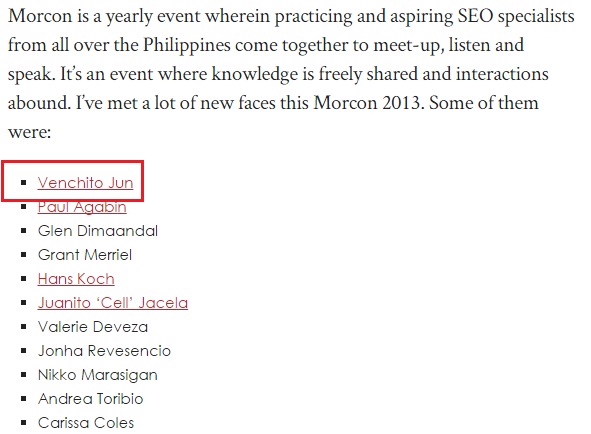

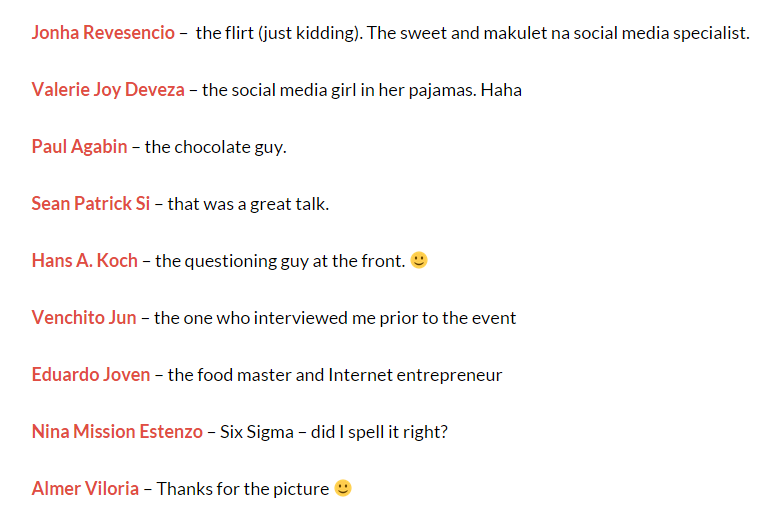

Push out strong context with high linkability intent
One of the primary reasons why most content pieces didn’t get much traction on the web – earning links from other niche-specific blogs is that they lack in uniqueness and strong opinion.
Expertise is best seen in content when the content creator justifies a strong argument and/or concludes one statement that makes as his/her main point in the page.
One of good example of how you can earn links through exemplifying a strong statement is this link from Hausman Marketing Letter.
As you can see in the image below, the author included the introduction of my post in his article, which I believe became the strong unique proposition of my content.
When writing highly linkable content:
- Cite external links or sources in your post where you got credible data from. No need to include them if they are information solely produced by your brand.
- Think twice or thrice before releasing a statement/argument. It can either give you a break in the industry or break your reputation literally.
- Provide unexpected hooks in your content that haven’t been published in other blogs. This gives you a high potential of getting cited because of your actionable points.
Invite industry experts to write content for your blog
One of the linkbait approaches that will still last effective even years from now is inviting industry authors to contribute a post for your blog. One reason is that this link building idea isn’t scalable and couldn’t be done in a regular basis unless you’ve got a long list of industry authors, whom you can reach out to for guest content contribution.
There are many ways to entice someone to create content for your brand, but here are some that you can try:
- Pitch an industry blogger with a proposition to expose him to a large audience (readers) and social (followers), in case, you’re a big brand that happened to have a new blog in your website.
- Initiate linking to his/her blog from any of your posts (whether old and new). Tell him that you linked out to his/her content via email or social. There’s an instant connection when you converse with him and had him respond to your messages.
- Provide free access to your brand’s premium products/services in exchange for his content.
Below is an example of a contextual link I earned from Glen Demands blog, which linked to his guest post on my blog.
This link building approach can help you earn links given that the guest author will cite his guest content in his personal blog and/or in his posts contributed to other blogs.
Offer to translate your content or accept an approval to do so
Translating in your content proves to be a very effective strategy to build contextual backlinks that will certainly pass ranking value and referred traffic to the linked page/content.
Since the translated content is published on another blog where the audience hasn’t been approached by the original author, the likelihood of absorbing new readers and social followers from the blog where content is translated would be higher.
A few considerations to keep in mind:
- Receiving pitches to translate your content is better than pushing your content out to potential linkers (mostly non-English bloggers). You might have a low chance to turn a conversation into one link primarily because of the language barrier.
- When approving a proposal to translate your content, make sure to check out their blog one in a while to see if they’re really linking out to your content/page (as what they have said in your conversation). You can also setup alerts for mentions (linked or unlinked) to ensure that the niche blogger is linking to your piece. You can use Monitor Backlinks for this approach.
- Invest in building content assets on one main topic (for example in my case, link building) to constantly remind your audience about your expertise, since this is the main reason international bloggers would want to translate your content and be published on their own blogs.
Here is a screenshot of an email that I received few weeks ago. It is a pitch asking for approval to translate my content in Arabic language.
Imagine if you published at least expertly made piece every week and three bloggers are willing to translate them to other languages and then, published it on their own blogs. That’s 12 contextual links every month with no effort and cost at all.
Accept interview opportunities regardless of the blog size
Interviews are content evidences of the expertise of a certain brand or author. Through answering industry questions, potential readers would have a better understanding on what the brand is and how capable the author is when producing articles for his blog.
I’ve been receiving a lot of interview opportunities these days and had been answering all of them as much as I can.
Here are a few things that I managed to do in the past few years with regards to interview linking opportunities:
- Accept interview opportunities regardless of the domain authority of a blog. What you want to build here is the momentum of earning interview links.
- Focus your answers on one topic. Though surely you will base them on the questions, but if they will ask you what topic you’re comfortable of discussing about, always try to focus on one (in my case, it’s link building).
- As soon as the momentum starts to build, you can answer questions from other sub-niches of your industry (in my case, it is affiliate marketing, blogging, conversation rate optimization and startup).
- Try to get at least one contextual link pointing to your page/content and one link for your brand.
- Never abuse linking to all of your content (this will only cause bad impression to your future potential interviewers).
Examples of recent interviews:
Leverage connections with industry curators
Curation is a content marketing approach that gains its popularity for the past several years, for the reason that it gives mutual benefits to the author of the page/content being linked to it and to the curator himself. The cited author gets a link while the curator has provided an article for his blog.
Engaging with curators in your industry could actually help your brand expand its audience reach, as you can be seen and visited by readers from other blogs, which gives another opportunity to earn another set of links.
Ways to properly engage niche curators:
- Leave sensible comments in their blog posts. Try to get their attention by answering their last question (their call to actions at the end of their posts) and/or cite an experience/example based on the topic of their post.
- Simply share your content without pushing them out to link to your content/page.
My recent links from roundup posts:
- 55 of the Best Link Building & SEO Posts of 2015 (So Far)
- SEOlympics: Top Marketing Blogs of the Philippines
- 246 Content Marketing Resources
If you are looking for a link building agency to partner with you, then don't hesitate to contact us today.
11 Linkbait Strategies That Will Help Build Brand Authority
Linkbait is viral content with the specific aim to attract links from the “linkerati” – this is a term coined to describe people on the web who might be able to give links.
Producing this type of content on a regular basis would help improve your site’s link acquisition process, build a momentous brand authority and passively achieve micro-goals for your business (increase email subscribers, receive more service inquiries, etc..).
Without further ado, let’s get straight to 11 linkbaiting strategies that you may haven’t been implemented to your link development campaign.
1. Topic consolidation with Email Digest
Generating ideas using content marketing tools is doable these days but the most crucial part is actually organizing them to come up with interesting and linkable topics.
Email digest from IFTTT helps a lot in this process. Using one email account, you can receive daily/weekly email updates on trending industry topics/themes that are likely to be suitable for linkbait content assets.
One example of email digest is this National Puppy Day trigger (image above) where you can receive daily updates on adorable puppy GIFs. This is one creative way to curate content pieces that are seasonable in nature, have a potential to go viral and can attract natural links from authority news sites.
You may want to check out this old but useful guide by SEER Interactive on IFTTT recipes for marketers.
2. Test headlines for clickbait strategy
Based on Copyblogger, an average of eight out of ten people will read a headline copy, but only two out of 10 will read the rest. This only proves the importance of writing enticing headlines in capturing the interests of a target audience to read your site’s entire post.
Peter Koechley, Co-founder of Upworthy said that, "The headline is our one chance to reach people who have a million other things that they're thinking about, and who didn't wake up in the morning wanting to care about feminism or climate change, or the policy details of the election”.
One way to improve the effect of headlines to page’s user/reader activity (i.e. time on page) is through headline testing.
Headline testing is a process of improving click through rates of a headline by first writing a few different variations of it, then asking respondents (targeted by age and gender) to vote for the best title and provide you the data – which title earned the highest vote.
For this specific activity, you can use TitleTester, a headline testing tool that doesn’t require split testing (back-end/front-end experiments) in order to determine which page title will yield the best result.
When thinking of headline variations, make sure you include your targeted keyword to your titles in order to help the page rank in search results for that preferred industry term. For the example keyword phrase, “how to increase blog traffic”, “15 Insanely Actionable Tips to Increase Blog Traffic” is a headline that can drive visitors to read the post and is good enough to help search engines understand the page’s context.
For more information on headline writing, you can check out this recent Whiteboard Friday on Moz.
3. Collaborate with influencers for add-on data
This is one of the main linkbaiting tactics that I’m executing lately for my blog posts – considering that the best way to attract initial authority links is through getting others participate in your brand’s content creation phase.
Influencer collaboration is not a rocket science activity, as you will only need to send an email or social message to an influencer, let him know of your upcoming post and ask if he is willing to share some examples of work/experience that are related to your page’s topic.
One value proposition that you can try out in outreach aside from the common bait techniques (monetary incentives, exclusive access to premium products, social/brand exposure, direct lead generation, etc…) is post preview.
Basically, you will include the add-on data to your post and contextually, you preview your readers on the upcoming article of your contributor.
As an example, my recent blog post on traffic generations included an experience-based tip from Roel Manarang, where he also shared some useful data to support his claim. One week after, he published a full case study about the same Facebook strategy he shared on my blog.
By using post preview as a unique angle to your outreach, you can increase your chances of getting a response(s) from your potential contributors.
4. Consumer insights using data and visualizations
The best way to produce user-interacted content is through generating insights and direct questions from consumers. This activity is often expensive as you would need to gather straight answers from your target customers with the help of survey tools like Google Consumer Surveys.
But today, you can collect consumer insights straight from Answer The Public tool and turn these knowledge to linkbait topics for your future content assets.
For example when you search for the term, “parenting”, this list of “which” topics could be seen in the page.
Now if you use your creative psyche to brainstorm content formats that will work best for the topics in the list above, then you would consider a “quiz” type of content.
The idea is to get your visitors answer multiple questions in the quiz (make it appear in the most visible areas of your site), then at the end, the quiz would give them results that will determine which parenting style they are currently using for their kids.
After producing your “linkbait content”, build your initial list of contextual links by reaching out to potential linkers in your industry (parenting/home-schooling resource pages and mommy bloggers). If the content is highly resourceful, the potential of earning links from those list prospects, as well as attracting additional backlinks from webmasters who would be able to consume the content is higher.
5. Build initial list length for maximum link potential
A good linkbait strategy has goals set in place. These could be exact figures (that are always approximate), which team members could use to push their efforts and capacity to produce campaign-driven results.
In link acquisition, setting goal links should be at topmost priority. Here’s a formula that you can use for maximum link goal potential.
As you can notice, the higher your target links are, the higher should be your initial list.
This becomes a useful tool in applying the Pareto Principle since you can simply focus on your initial list (initiate the outreach) instead of prospecting for additional link opportunities across your space.
6. Add on-page FAQ sections to highly-demand product pages
Frequently asked questions are tools for B2C / SAAS websites in nurturing interested customers with information that will trigger them to purchase the brand’s product/service.
In most cases, these FAQ sections are cited on many industry related web properties such as forum threads, where users are asking for more details about a specific product/service.
If your brand has built a good level of authority, then chances are your customers may have questions pertaining to your brand’s offerings, which may be visible on popular Q&A sites/forums.
Find enough volume of specific product related questions on industry community sites/blogs. Do a Google search for “brand” “product name” OR “service” then compile a list of questions you’ve found.
For newly existing brands, you can execute the same approach – Google search for “product name” OR “service”. There would be more product related question here since you’re taking it in a non-branded view.
Add on-page FAQ sections or quick links below each product page.
Make these sections linkable by placing them on visible areas of your commercial pages.
7. Content ideation using news aggregators
News aggregators are compiled volumes of the latest articles from top news sites.
One good example of this is Talll.
This makes your content ideation process easier as you can simply jot down notes or brainstorm topics that are most discussed in your niche based on the latest news you’ve seen in a news aggregator.
Combining this function with word cloud, the content brainstorming phase could be much simpler.
Grab the titles of the latest posts and plug in the all to wordle or any other cloud word tools.
You can simply generate industry themes/topics based on the visuals that the tool will produce.
8. Turn internal content to linkbait
For companies that conduct daily/weekly trainings, most of the time, they dug their internal content in their database – leaving it invisible to the public.
This type of content, when published on a blog, could significantly bring a good amount of editorial links to the brand since they can be referenced by publishers and expert writers from related industries, especially if the internal content is the most comprehensive resource on a particular topic.
Turn list posts into slide decks.
If the post itself managed to get traction after it was published, then chances are its converted content (slide decks) could also earn direct traffic from people who have read the post.
Find list posts in your blog that earned a good amount of natural links and convert them to visual content.
Include some quotes or citations from linkers of the original post to increase the odds of getting responses from your outreach.
Reach out to people who linked to the original post and let them know about the new version of the post.
9. Dig link opportunities with Youtube
Incorporating social media in today’s link building game is definitely one of the best moves of a seasoned link builder.
Youtube is a link building platform that can open blog link opportunities for your brand, since there are millions of viewers searching in this social search tool almost every minute, coming from different industries.
To start with Youtube link acquisition, find popular and/or untapped keyword phrases in Keyword Planner. A good amount of search volume here may comparably be tangent to search volume in Youtube as well.
Go over to Youtube and do a search for that keyword phrase. See what videos pop up.
Look for videos that are outdated but have gained thousands/millions of views in the past.
Be mindful of your industry’s search environment, as some niches like cooking should obviously have millions of views each month.
Recreate the content by publishing an updated version of the video and/or publishing a visual that shows the step by step instructions on the same subject (in this example: how to make a cake).
When your own version of content is published, you can now reach out to existing linkers of the original video, which you can find using link prospecting tools like Ahrefs (review here) or OSE.
Tell them about the new version of the video content. The potentials of earning links would be higher since you’ve shown the improvements of your latest asset.
10. Invest in linkable visuals
Visual content is a good brand asset that enables information to be more easily consumed by a target audience, since they can absorb fractions of data/message within a few seconds, simply by looking at the piece.
One of the visual content pieces you may be familiar with is infographics.
Infographics are not dead and many search marketing and B2C companies are still using it to capture a particular group of people, funneling them down to the sales funnel and potentially become their customers/clients.
It’s how infographics are made that make it dead or alive to a content/link building team.
In our latest SMX-style conference, PeepCon, Jayson Bagio shared a very interesting process on how infographics can naturally build links from relevant blogs/sites. You can find the presentation below.
Investing in linkable visuals will work if they are carefully planned and executed.
Results from the campaign should also be analyzed to make necessary actions for constant improvement.
11. Reputation linkbait
Influence marketing is still one of the best linkbait strategies given that the value proposition here is the industry expertise of the content creator or brand.
There are many ways to actually execute influence marketing and some of the notable and common tactics are the following:
- Build more expertly-made content both in internal and external web properties. Make it as comprehensive as possible, so potential linkers could easily remember the brand’s identity through the depth of the information/message being conveyed in the content.
- Participate in industry web communities by answering niche relevant questions where you can provide unique insights on particular subject matters.
- Build strong relationships with influencers and bloggers through offline efforts like networking at seminars/conferences, webinars and/or simple conversations via email or Skype.
You may want to check this linkbaiting post by Jason Acidre on his Kaiserthesage blog.
If you are looking for a link building agency to partner with you, then don't hesitate to contact us today.
19 SEO Experts Take On: Getting Good Links Alone (Without Link Disavowal) Can Remove Penguin Penalty
It has been an intriguing discussion in the SEO community when John Mueller (Google Webmaster Trends Analyst) answered this question:
If the majority of the links become the quality links, would this help a person to remove or would Google robot remove the Penguin penalty?
His answer was straightforward, “That would definitely help. Yeah.”
More information on the Q&A portion here: https://www.seroundtable.com/google-disavow-good-links-penguin-19696.html
Moving forward, last week I asked 19 SEO experts to answer this specific/similar question:
Can good links alone get you out of a Penguin penalty even without disavowing the bad links?
The answers are listed below but to give you a short statistics. Here is what I’ve found out.
So without further ado, let’s hear what SEO experts say on this topic:
Eric Enge, CEO of Stone Temple Consulting 

Google’s John Mueller confirmed on January 12th of this year that getting good links can get you out of a Penguin penalty. He did that in one of his Office Hours hangouts. You can read the write up from Barry Schwartz here: https://www.seroundtable.com/google-disavow-good-links-penguin-19696.html
That said, what you don’t know, is how many good links you need to get. If you have been hit by Penguin, it would remain my advice to go through a link cleanup, removal, and disavow process. This will pretty much always speed up the process, and when you have been hit by Penguin you always feel the need is urgent.
On the flip side, I would also never simply to the link cleanup/removal/disavow either. You always want to be earning good, high quality links.
Dan Petrovic, Director of DejanSEO 

This is a dangerous statement, taken out of context of what has actually been said. Penguin is not an on and off algorithm and as such has a gradient of impact. This means that a marginally affected website can overpower the negative effect if it just minds its own business and keeps on a whitehat path. That said, why would you do that? If you're in the business of optimisation you'd want to be responsible and actually optimise the situation by minimising the negative impact of the algorithm through disavowing all known toxic links. So in short, yes in some cases but you'd be silly not to take proactive approach to shorten or minimise the impact.
Cyrus Shepard, Senior Content Astronaut at Moz

Can webmasters escape Penguin jail without having to use the disavow tool? Yes, I believe not only can they, but in many instances they actually do.
Google representatives have made comments recently to indicate that Penguin works by examining ratios between good links and those deemed manipulative. While this is likely an over-simplified explanation, it makes total sense. Sites like Amazon, by their very nature, have a huge number of "unnatural" links in their profile, but these are potentially dwarfed by the number of good links that helps prevent most Penguin actions.
So the goal of the webmaster faced with solving Penguin is to improve the ratio of good links to bad. Using the disavow tool is one quick option, but one that also risks thowing out good links with the bad. An optimized strategy would also include considering a few of the following strategies to improve your link ratio:
- Build more good links
- Remove bad links through manual outreach
- Do nothing, let bad links atrophy and disappear (takes a long time and is lazy, but I've seen it work in some cases)
In fact, Google itself recommends using the disavow as a tool of last resort, and there are many viable alternatives that may actually work better.
Richard Baxter, CEO of Builtvisible

Honestly, I don't think so. You'd have to increase the links to a domain an order of magnitude higher that whatever the current level (theoretically) is. Even then, I don't know because if it's a manual intervention surely it wouldn't be enough. Maybe if it was algorithmic in nature. Like I said, I wouldn't be too sure and I wouldn't want to risk the wait.
That's why it's smart to address a penalty and put *all* of your marketing energy into the link removal (I much prefer link removal as the primary solution) and Disavow (if the bad links can't be removed).
Larry Kim, CTO of Wordstream 

Yes! Spammy links are measured on a relative basis not an absolute basis. Meaning, it has to do with the mix of good vs. garbage links pointing to your site, rather than just the absolute number of junk links. For example, a site like the NYTimes might have millions of junk links (from scraper sites, etc.) but have hundreds of millions of high value editorial links, so no penalty despite potentially having a high number of junk links. Thus it is often a much easier and scalable strategy for companies – especially companies who have an established brand, to pursue higher value links rather than attempt the seemingly impossible task of removing a large volume of links from sites you don’t control, or reviewing a link profile of millions of links and manually disavowing the junk links.
James Norquay, Director of Prosperity Media 

Firstly you need to make a clear difference between Manual penalties and algorithmic action as they work differently. You are not going to get out of a "Manual Penalty" with only good links been built as you will need a disavow/ link removals as part of a reconsideration process. In regards to algorithmic action their is possibility to get out of this action by building a significant number of high quality links to your website to "dilute" poor quality links when the next algorithm runs. Tho it is still highly advisable to build a disavow as your website can be targeted by Algorithmic action and further along the track be targeted by manual action due to non disavowed links in your link profile. We have seen this happen to businesses in the past who are not savvy with this type of work.
Now in regards to case studies we have had a few here is one from a portal based client were building quality links was part of a recovery process as noted here - http://moz.com/ugc/increasing-organic-seo-traffic-by-400000-unique-visitors-a-month
Todd Malicoat, Founder of Stuntdubl.com 

While there is always a possibility that a domain could acquire a lot of high quality links to trump a penguin penalty, I don't think it is often the case. Most penguin penalties stem from a lot of poor decision making around link building, or even negative seo impacting a domains rankings. While there used to be "no bad links", that is no longer the case. The use of disavow is important to the level of required regardless of the organic growth of your link profile, if a company has been engaging in questionable linking strategies in the past and incurred the wrath of a penguin penalty. While it is possible, it is certainly not optimal for best chances of success.
Mary Bowliing, Co-Founder of Ignitor Digital 

As with many SEO questions, the answer is it depends. If you have a manual penalty in Webmaster Tools, then the chances of getting out of it without playing Google's mean mea culpa game are slim to none in my opinion.
If you have an negative algorithmic impact from Penguin, it may be possible, especially if you don't have many links to begin with and the bad links are from low authority sites. In those cases, continually beefing up the link profile with stellar links from relevant, high quality sites will have a positive effect over time. However, it can be a slow process that can be speeded up via disavowals.
I think too many SMBs and smaller agencies go overboard with disavowals and throw the baby out with the bathwater. The cause seems to be a misunderstanding of what's going on and the inability to distinguish bad links from good ones, so they basically end up starting all over at ground zero with links. While that's a very safe approach, regaining rankings can be painfully slow. With a more incremental approach, you can disavow your worse links and see what kind of response you get. Then take those hints and try again. I'd rather go through the disavowal process a few times and keep what links I can than toss them all away and start all over.
Peter Attia, Founder of Cucumber Nebula 

I admittedly have little experience getting websites out of a penguin penalty. However, in the few times I’ve dealt with it, I’ve felt that a balance of both getting good links and disavowing the bad were required. I think heavily focusing on one or the other allows room for error. For example, I’ve seen people disavow links, not see any changes, and then continue to disavow links that were genuinely good and beneficial.
If you continuously rotate your focus on getting good links and disavowing bad ones, you negate the possibility of overcompensating.
In some circumstances, I think it’s better to just start over with a new domain. In which case, you could just go after good links and not worry about disavowing. This also gives you the opportunity to reach out to web owners and change your solid backlinks over.
Giuseppe Pastore, Founder of GiuseppePastore.com

I don’t have precise data to share in this case, but in my opinion is that it should be possible. We don’t know for sure which is the limit before getting hit by Penguin, and each link related signal might have its own threshold, but I can hypothesize that getting good links somehow adjusts your “Penguin score” and if they lowers it enough you are again out of the red zone.
This is very simplified of course, but it’s like adding salt to water: it no longer boils at 100°C. Good links are like salt: the more you add, the higher is the threshold for the new mix, so if you were very close to the previous, lower limit you’re now under the new one and you get back out of Penguin.
The real problem is understanding how much you’ve passed the limit and how many good links will bring you back. I fear there’s no answer for this and you might proceed by trial and fail.
Harris Schachter, Founder of Optimize Prime SEO 

This is an interesting question, and personally I think it is a loaded question. I am sure it is possible to overcome a penguin penalty without disavowing links, but the handful of times where data strongly suggested penguin involvement, I always used the disavow tool.
Now, you won't get over such a penalty just by disavowing links (at least I've never seen it). You need to supplement such efforts with signals of quality - aka good links, positive UX metrics (low bounce, high time on landing page) and mentions/co-citations help too. For this proactive piece, natural search traffic increases from other engines than Google too, and when you see that you're on the right track.
So, to the question of do you need to disavow links to get over the penalty, my intuition tells me no; but experience tells me yes.
Brett Snyder, Founder of Knucklepuck 

Not only do I believe good links alone can get you out of a Penguin penalty, I'm of the opinion this is the only truly effective way to do so. Google's algorithm is built off 3 core principles: trust, authority, and relevance (TAR). "Penguin links", as we'll call them, contradict these principles, whether intentionally or not. Focusing on simply disavowing links doesn't actually give Google any new signals that support your TAR and therefore gives them no reason to view you as a more credible source.
We know that link depreciation exists, meaning that the older the link the less weight it carries. This is especially true for "Penguin links" because these sites themselves present no signals that support their own TAR. We also know that Google is aware of negative SEO and "works hard to prevent other webmasters from being able to harm your ranking," implying that they look to reconcile all the ranking signals associated with your site to determine TAR. Lastly, we know that Google is processed by an algorithm, meaning it uses a holistic approach to evaluating links at scale. They look not only at the link itself but also the page it is linked from, the domain that page is on, and the Trust, Authority, and Relevance associated with that domain. "Penguin links" are significantly discounted based on this, so any other signals we can establish will weigh heavily into how our site is perceived.
Therefore, the 2 biggest things you can do are:
- Focus on implementing strategies that support Trust, Authority, and Relevance, understanding these are the criteria Google uses to evaluate ranking potential. Google looks for supporting signals and the more supporting signals you can present, the better impression you'll be able to present even if legacy signals are suboptimal.
- Monitor new links to ensure there are no new signals that would contradict the TAR you're promoting for your site. Google's algorithm is constantly evaluating and re-evaluating your site and ensuring that we're establishing the right signals will influence how the site is qualified.
Marie Haynes, Founder of His Web Marketing 

I wrote about this subject recently on Search Engine Watch (http://searchenginewatch.com/sew/how-to/2392097/can-you-escape-penguin-simply-by-getting-good-links ). While I think it is in theory, possible for good links to override bad, in practice I think it would be pretty rare. Most sites that are able to attract true, natural links in high enough numbers to override the bad links, probably weren't involved in creating bad links to start with.
John Mueller has said that Penguin is like a filter that causes you to be driving with the handbrake on. In other words, even if you were able to get enough new links to override the distrust that the bad links give you, you would still have your progress hampered by those bad links.
I've seen a lot of sites recover from Penguin, but I've yet to see one recover without doing an extremely thorough disavow.
Traian Neacsu, Founder of Ecommerce Marketing Books 

Based on my experience, no. But it may also depends on how bad the profile is. If 90% of your links are spammy, then 10% good links will do no good. If 10% of the links are bad, then any good link will help. And it also depends on how nasty a bad link really is - for example, if Google finds out you paid for just one link you will get a manual penalty and will stay there no matter how many other good links you get.
Piers Moore Ede, Founder of Barefoot SEO 

There's no easy answer to this question, but I would tentatively say yes. What seems to be happening now with penalties is that Google is assessing how important you are as a brand, how big is your reach in the real world. Interflora is an obvious case in point: they had enough spam to offer a definitive coup de grace to most sites and yet, lo and behold, they were ranking again within weeks. There seemed to be two reasons for this: one is that Interflora is a huge Adwords customer and so Google may doesn't want to completely bite the hand that feeds them. The second factor is that Interflora is the biggest florist in the world and Google simply couldn't offer a good service without them at or near the top. All of this is a roundabout way of answering your question: 'Can good links save a penalise site?' Here I take 'good links' as a synonym for what Jerry West calls RCS (Real Company Shit). That means there's just no shortcuts anymore, you have to get out there and build the best relationships you can, resulting in the kind of diverse, natural, authoritative link profile which shows Google that, although you may have been bad in the past, you're not only reformed but you're someone too important for them to keep out in the cold.
Andrew Shotland, Founder of Local SEO Guide 

We see this all the time with sites that got hit indirectly by Penguin most likely because the majority of their backlinks were from crap sites. So those links got devalued and the site lost its rankings. In cases like these, they just need to get new non-crap links to start building "authority".
Joe Simmonds, Founder of SEO Success Melbourne 

From what I've read and what I'm seeing with some client accounts, I'm getting the feeling that Google isn't handing out such harsh penalties for building bad links. It looks like they're choosing simply not count links from bad domains. I'm guessing that the harsh penalties that were handed out after the original Penguin algo roll-out were enough to get the disavow info that Google needed to figure out which links to just ignore. I could be way off the mark with this one but I think that may be the case.
So... can you recover from a Penguin penalty without disavowing bad links and only building new high-quality links? I think that the answer is yes, provided that the number of bad links was only just enough to trigger the penalty in the first place. Having said that, my advice to anyone with a manual link spam penalty would be work on removing all bad links and to disavow any that remain.
Bottom line is still that it's a dumb idea to build shitty links to your website. Go with business directory listings, social media profiles, real blog comments on good blogs, press releases, social bookmarks and links from businesses that you deal with in the real world.
George Stevens, Founder of NebStone 

From my experience the quickest most effective way of getting out of a Penguin penalty is through disavowing bad links and don’t be scared of disavowing too many.
Google look at ratio of bad to good links so you could perhaps technically get out of a penalty by generating a high number of good links instead of disavowing bad links. However this would depend on how serious your backlink profile was looking – if you already had thousands of backlinks and 75% of them were bad links then it would take a long time to generate enough good links to balance out your backlink profile. If you only had a few backlinks then it may not take long to build a set of good links that would counteract any bad links you had.
However it wouldn’t seem sensible to ignore your bad links and only focus on building good links for a couple of reasons
1) If you want to increase your ratio of good to bad links in order to remove a backlink penalty, the quickest way to do this is through disavowing bad links (and building good links at the same time if you want to). Focusing on removing a penalty through building good links alone could take a long time.
2) It is a riskier method just focusing on building good links. You may think you’re building good links however Google may not agree, particularly in light of your link history, so in some cases you could even be making your penalty even worse.
3) Even if building good links works and removes the penalty it would still seem sensible to disavow bad backlinks as this can only increase your ratio of good to bad links.
Paddy Moogan, Co-Founder of Aira 

being built, they were still clearly suffering from a penalty and their traffic was not at the level we'd have expected given the links that were being built.
If you are looking for a link building agency to partner with you, then don't hesitate to contact us today.
Better Link Qualification for an Efficient Link Acquisition
Link building has been existent over the web for several years even before it was considered by search professionals as part of the search engine optimization process.
Links remained to be a valuable tool for Google to determine if the site/page/brand is deserves to rank in search results, which are primarily based on how popular a brand is (since Google is getting more brand-bias these days), how authoritative the page (through links acquired over time) and how trusted the site is (minimally based on social metrics and the overall trust flow of the site).
Given the truth above, it is very important to learn how to create an efficient link building process, wherein links would just flow naturally with a considerable speed and duration period.
One of the proven ways to streamline the flow of link building activities is to maximize the time spent for each task, allowing team members to focus on the most important workflows in order to yield better results for each link building campaign.
Time maximization is achieved through qualifying existing and future link prospects based on the campaign’s minimum standards. The more refined your filtering process is, the more time you can save from undue costs of unexpected results of irrelevant and low quality link targets (since these targets will not certainly produce the same yields like that of your high-end link prospects .
Better link qualification is essential for an efficient link acquisition.
There are two methods of qualifying your pre-existing and existing database of linking pages/sites.
- Pre-qualification
- Metric-based qualification
Let’s dig into each processes mentioned above.
Pre-qualification
The common flow of campaigns looks something like this (see image below):
Whereas link targets normally undergo in the qualification process to see if they pass the standards set by the link building manager.
For large scale link development campaigns, separating a huge amount of wheat from chaffs in the qualification phase will take a much longer time than simply pre-qualifying link prospects during the prospecting phase and only including link partners in the list that are likely to be qualified as high end link targets.
Find websites that are linking to all of your competitors’ sites. You can use Moz’s competitive link finder to see which brands are actively linking out to relevant websites in your space.
Understand how your competitors acquired backlinks from them. See if links are voluntary rewarded by your potential link targets (i.e. competitors established their authorities and thematic brands simply just mentioned them from their own sites).
You can base your content theme on potential link targets and on the pages they linked out to. Find a content topic that is aligned to information in pages mentioned by your potential link targets.
Remove page loading barriers such as advertisements when doing link prospecting in order to quickly see if the page is the right prospect for the campaign. Header advertisements tend to capture your 2-3 second attention, which is already an enough time to decide if the page/site is worth to add to your backlink database.
Elements of the page that fasten my ability to pre-quality a link prospect:
- Relevance of the site/page to my client’s brand (look at the brand’s logo, header and categories).
- Content that is below the fold (close the tab immediately!).
- Too many headers and sub-headers (indication of unplanned site architecture).
- Multiple site categories that go beyond their main content theme.
- Non-pleasing design (this may affect the engagement rate of visitors trying to visit that site, which is a main factor to consider if you want to bring relevant visitors to your brand). These elements are pretty easy to use when doing a quick analysis of the potential linking site/page.
Another way to pre-qualify a potential link opportunity is to note other link acquisition tactics (not prioritized during the day) that you can use for one specific link target in your spreadsheet.
Instead of removing linking pages that are not necessary for your current link building technique, why don’t you just transfer them to other tabs or spreadsheets? So you can easily find them once you need targets for your next link acquisition tactic.
Use Ahrefs, OSE or any other third-party link analysis tools to export a list of all your existing referring root domains. Check out if there are opportunities to acquire recurring links from them (see if there’s a blog and it constantly publishes link-obtainable posts like regular third-party contributed content, round-up posts, list post, etc..).
Pre-quality your current link targets based on the level of relationships you had with webmasters and bloggers. Conversion rate is much higher when there are previous connections given that conversations are pretty much shorter than the usual time spent with non-engaged link partners.
Practice every activity I mentioned above in order to remove unqualified link targets even during the link prospecting phase so you’ll not waste time getting them to undergo your main qualification process and still will not pass your set link standards.
Metric-based qualification
This is where your main qualification phase takes place, which are solely depend on what metric(s) you’ll be looking at to qualify every link prospect in your database.
I’ve covered a few qualifiers that you can use for each link building method you are executing.
Domain and page authority
This is a metric popularized by Moz that calculates how likely a page will rank in search results. The higher the domain and page authority of the website is, the better it will perform in SERPs. If you want to learn more about how domain and page authority are calculated, check out this page and this.
Don’t solely rely on these two metrics since they just estimate how ranking potential of a page/website. You can accompany DA and PA with Majestic SEO’s trustflow.
Trust Flow is a number predicting how trustworthy a page is based on how trustworthy sites tend to link to trustworthy neighbors. The higher the trustflow of the domain is, the more you should acquire a link from it.
Indexation
Indexation allows you to determine if your potential linking domain is getting found by search spiders. This is important since you want that the pages where you’ll get links (either old or new) will be found by new visitors from the search engines.
To check if your domain target is indexed in SERPs, simply do a Google search for site:domain.com.
See if the homepage is listed in the top of search results.
If the branded pages of the domain are indexed, then consider the website as part of your link database.
Number of linking root domains
The quantity of individual domains linking to a specific website is an indication of how a site is trusted by other brands in the industry. However, you have to check backlinks from those root domains to see if they’re editorially mentioned your backlink prospect. If it the link was given voluntary, then consider the website as your high-end link target.
Link velocity
Use link profiling tools like Ahrefs to see the growth of the link profile of your target domain. This can help you identify line patterns that may suggest an unexpected increase of backlinks over time.
If there are continuous hundreds of links every week and thousands were added within a single week, then there may be manipulative actions that were done for the target domain. Skim backlinks pointing to that domain to check out if they are legit and credible enough to consider by Google.
Algorithmic update proof (content and link-based)
Looking at the past search performance of the website can help you determine if there’s a big likelihood that your linking pages will stick in the domain for the longest time, since there are cases where websites that had been slapped by Panda or Penguin filters will soon gone out from rankings in the search results.
Use SEMRush to see the historical data of the site particularly on its organic search data. Then refer to this Google algorithm change guide on Moz to check if the site was hit by a content/link-based penalty on a specific date/month.
Content above the fold
When top heavy update was announced by Google, many websites with so many ads that buried down the contents in their homepages were penalized by the said search engine.
In that case, when you’re looking for a blog to target for distributed content, you’ll have to see if multiple ads (of whatever type) are pushing down the contents in the page. If you find one, then remove that to your list of backlink opportunities.
Qualification methods shared above will help you get the best results for your campaign as you are able to filter out unnecessary link targets even during the link prospecting phase.
We recently launched our new agency - LinkCore Media, a link development and content marketing agency. If you’re looking for a high quality link building service, then you can contact our team to help you create a link strategy that fits your brand and industry.
Natural Link Acquisition That Drives Search and Referral Traffic
From the first release of Penguin filter to its constant updates being made by Google, many link developers had almost transitioned themselves from pursuing unnatural linking practices to executing link building tactics with business goals in mind.
The transition wasn’t easy given that search professionals and agency owners should be aware of the requirements of a solid link building campaign (i.e. content development costs, labor costs, extensive time and effort, etc..) which most of the clients I’ve worked with didn’t want to invest in those project costs.
I believe those brands who want to win over their competitors on the web need to understand the value of link building in the post-penguin era – which is far beyond the common main target – links.
Several reasons why manual/natural link acquisition is the way to go link building approach in this digital age:
- It can help achieve both short term and long term business objectives.
- It improves branding through exemplifying authority and expertise on other websites’ pages and contents (news, articles, press releases, etc..).
- It helps build a natural link profile, which is what Google wants in every website to have and to maintain.
- It builds trust from search engines and users – which is a primary reason why customers and brand evangelists would eventually follow the brand.
- It can positively affect sales and business growth.
Here are a few natural link acquisition tactics that I personally use to achieve overwhelming results for my clients.
Search-dependent link acquisition
Relying on search in order to continuously attract incoming links to a specific page/website is the basic link building principle we all know as search marketers.
The higher the page’s ranking is, the higher are the chances of acquiring new links to the page/site from bloggers and researchers who’d like to reference the content from their own works.
Search-dependent link acquisition could easily be broken down into three steps: identifying keywords to rank for, creating content on a specific topic/keyword and manually reaching out to potential linkers.
Identify keywords to rank for
Keyword research is the most basic skill in search marketing (if you still don’t have any background on it, you can check out this great resource on Backlinko).
When finding topics/keywords to target for a page/content, your top consideration should be its referential ability. Do people searching for the keyword want to reference any page in the search results from their own blogs/sites? If yes, then add that keyword to your list of potential content topics.
This phrase – “how to use pesticides safely” is referential in nature (bloggers/researchers searching for this phrase would likely link to top useful pages in search results). While this term – “what is pesticides” can easily be answered by a short form content. The comprehensiveness wouldn’t be necessary given that searchers can be satisfied quickly with the definition of that term (pesticides).
Keywords with high search volumes are the best phrases to target in content marketing. In many cases, this principle is true, but it doesn’t mean that along tail search query that doesn’t have a significant search volume is not worth considering.
Consider medium-based keyword and long tail phrases when finding the best term/keyword to target for your future content asset.
Identify the linking potential of the keyword by analyzing the top pages in that specific content. Get 3 ranking pages in the search results.
Examine each page and find linking patterns in the last one or two months. Does the page earned links in the last month(s)?
Go deeper by analyzing its’ new links for the past one or two months.
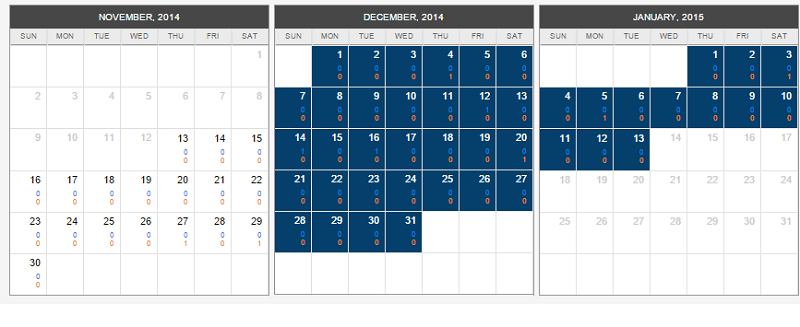

With that approach, you can estimate the average # of links you can acquire from ranking your page for that specific keyword (though this varies because your future content might rank for other related search terms as well).
See if all domains ranking in the search results are highly authoritative (with high domain authority and trust flow – a metric used by MajesticSEO). If the top 20 domains in the search results have domain authority of 50 and above and you’re a new brand in the industry, consider long tail queries.
Consider the evergreen nature of the keyword. Once you target it, ask yourself, “do you need to constantly update your content to stay ahead of the competition (among all ranking pages)?”. If it only requires semi-annual or annual content update, then the keyword is good to consider as an evergreen topic. One example of an evergreen phrase is how to get out of debt (which will only take you once a year to update your future content if you target that keyphrase).
Determine if there are several linking opportunities from pages ranking for the keyword (see pages that linked to ranking pages). The more resource pages you see from other sites/competitors, the better off you’ll receive visits from them through referral.
Check out commonly asked questions in forums and Q&A sites and see if there’s a great linking potential when you target those questions/phrases using the approach I shared earlier.
Finally, assess your brand’s resources. Are you capable of creating the best content on the specific topic/keyword you’ve chosen? Best content requires expertise to step up in the game and get the top spot in the search results. However, there are cases where you only need a thorough research to provide uniquely useful information in your content – you can outperform ranking pages by focusing on other content elements – visually appealing design, higher number of words, more tips, etc..
Create content
There’s no need to discuss why content is king (check out this resource if you need to).
I’ve written several posts around content creation, but just a recap of what I’ve shared in the past, here are a few tips you can immediately apply to content development.
- Understand the intent of the searcher. Make your best effort to provide the most exact and useful information on the specific keyword/topic you’re trying to rank for.
- Invest in design (“It’s the 50% of the battle”, says Rand Fishkin).
- Remove unnecessary internal and external links within the body of the content to help users focus on consuming the overall texts in the content.
- Use data-based elements (case studies, graphs, brand’s internal research) to support your own opinions/insights.
Practice submitting your content to higher-level managers or clients for content approval in order to get feedback and suggestions from them. This approach will likely improve your strategy when creating content for your future content assets.
Manual outreach
There are many ways to build links to one’s content nowadays, but the following tactics are the most effective ones:
- Resource page link building – reach out to links/resources pages and suggest to replace the broken link(s) in the page with the link pointing to your brand’s content asset.
- Content contribution – pitch industry-related blogs and ask if they’ll be interested to get you as their regular content contributor (links from third-party contents will be pointing to your content asset).
- Linker outreach – manually send emails to potential linkers and simply share the brand’s content (if it is highly useful, then there’s a high possibility to get a link).
Manual outreach requires research, discovery, due diligence and negotiation, which is the main reason why a link is so expensive.
Useful resources on manual outreach:
- Targeting Outreach and Influencers for Social Traction
- How to Create a Winning Content Promotion Plan
Once the content starts to rank highly in search results, it will receive continuous flow of search visits – a big part of them are bloggers and researchers who would likely to link to your brand’s content.
Traffic generators
Building links that drive relevant traffic to the site is one of the effective natural link acquisition approaches given that it assures the relevancy between the brand and the linking site/page (higher visits means the brand is topically relevant to the linking blog/site).
Traffic generator links will also accumulate additional in-content links from another set of bloggers/researchers (those who visit the brand coming from the linking site/page).
Be strategic with what how you place your link within the content’s body of your third-party contents (guest post, news pitch, etc..) since that will determine how relevant and useful your page is (which would help your new visitors from other sites to decide whether to link to your page or not).
Contribute to sites with high search and market share to increase your chances of ranking your external content for long tail niche-specific keywords. The more traffic it receives from search, the likelihood of getting referral traffic from other sites and attracting more natural links to your internal content is higher.
Track unlinked and linked mentions of your brand to identify linking pages where you can pitch and acquired another recurring links almost every month (roundup posts, list posts, bloggers list post, etc..).
Participate in industry-related forums with the intention of driving click through traffic from community sites and bringing new potential linkers to your page/site. That objective could help you increase your natural links from bloggers and webmasters who’re looking for references for their own contents.
We recently launched our new agency - LinkCore Media, a link development and content marketing agency. If you’re looking for a high quality link building service, then you can contact our team to help you create a link strategy that fits your brand and industry.
Link Building for Brand New Websites
Links will always play a very important role in search aside from the fact that it is where most search engine algorithms depend on – it is an effective branding tool.
For companies that have been around for more than 5 or 10 years, it’s easy for them to attract links and build a follower base because of the expertise they’ve shown during their existence (through content hosted in and outside of their websites).
But when you’re still new in the industry, whether you own an affiliate blog or a corporate site, the challenge lies on the capacity of your brand to influence the community (in which content will be required) and to create solid relationships with fellow business partners and customers.
Relationship building and creativity - that is the battle of link development today. Look at Brian Dean and Jon Cooper. Both of them managed to build an authority and influence in the search engine optimization and earn trust from their target audience within a short period of time because of what they’ve devoted in creating useful and visually-appealing content (creativity) and making it accessible to interested users (relationship building in outreach).
New brands can compete with old and bigger brands. It is a matter of consistency in applying the 80/20 link building principle, which is basically focusing on the most important processes, activities and tactics that will get maximum results with minimum amount of efforts.
That principle is what I've been practicing for my new client who has a brand new website (a 2-month old blog without pre-built blogger relationships and has only 5 posts when I started working on it). The campaign just started in November and within two months’ time, we earned and built high quality contextual links to the website.
Here are a few methods that you can immediately apply to your brand new website to get tremendous results for your campaign with fewer resources required.
Simple content planning and production
In this age of digital marketing, we consider content as king because it is where most online marketing activities rely on (conversion rate optimization, email marketing and link building).
Link building and link earning depends on the quality of content produced by the brand. The more uniquely useful content is, the higher is the chance of attracting more valuable links to the site.
Get a good grasp of what’s working already in your niche by analyzing your competitors’ content assets. You can outperform their work by publishing a more updated and comprehensive resource.
Fill a specific need that hasn’t been satisfied by your competitors through publication of new pages that is targeting any of the following evergreen topics:
- Frequently asked questions (FAQs)
- Glossary (e.g. Page One Power’s link building glossary)
- Complete list of strategies, tactics and plans (e.g. Backlinko’s complete list of CRO techniques)
- Best tools or products in the industry (e.g. Kaiserthesage’s recommended SEO tools)
You can find more content ideas by seeking the top pages in your space, using social, authority and link-based metrics. Do a simple content analysis on other brands/industries using Buzzsumo.
Develop link building workflows
For tasks in link development that are repeatedly executed, it is important to develop a single workflow to each of those link building activities.
Having a good process to follow every single month can improve productivity and can help the brand to focus on the more crucial parts of the campaign.
As a consultant, it is essential to teach your clients on the basic principles of link building in order for them to understand your process, trust you even more and avoid conflicts, which commonly result from miscommunication and misunderstanding on certain aspects of the campaign.
Community engagement
Engagement matters in link building because this is where most highly valued links start with. Editorially-given citations are acquired through conversations that add value to both parties (sender and receiver/potential linker).
Links driven from community engagement doesn’t only limit email outreach but in participating in relevant discussions on forums and Q&A sites.
Identify community threads that answer direct questions from customers. Penetrate and add a link back to your site – this engagement can drive conversion-oriented visitors to your brand over time (where to buy [product/service], I want [product/service] inurl:forum).
It is also important to understand how community users interact with each other given that this is where your engagement approach will be based on.
Eli Overbey recently published a post on his blog about the 10 lessons he learned from analyzing the top 1300 submissions to inbound.org last year. These lessons are mainly factors that can make one submission the best pick of the day/week in Inbound:
- Best day to submit (Monday)
- Great month to submit (January)
- The higher the word count, the better (2000 words and above).
- Title length is 56 characters in average.
- Top categories (SEO, content and social)
Discussions that are discovered by thousands of community visitors have same elements that make them stand out from the rest of other threads. Whether it is the day/month of submission or keywords that people are commonly searching for, users are looking for the same thing.
Identify those unique elements in your industry’s community platform, start your own valuable discussion and let others participate in it.
Linker outreach
Nowadays, linker outreach is still one of the best content promotion tactics given that it doesn’t require tons of money to execute (it’s purely time-intensive).
Aside from being a cost-efficient technique, linker outreach provides great results in terms of acquiring editorial links through search and social that is mainly dependent on how the brand is perceived by the users and the quality of content being promoted to the community.
An editorial link is one of the most powerful links because they are given voluntarily by potential linkers and are often clicked through by users, seeing that this type of link is placed within the body of the content.
For newly launched websites, earning editorial links through linker outreach is a great start to build a natural link profile from scratch. This kind of approach is what Google wants because in-content links from blogs, columns and news sites are mostly value-driven (either a content being shared to industry bloggers is worth getting attention or the approaching brand is starting to build its authority and expertise in the industry).
There are many ways to improve your linker outreach process this year in order to earn more editorial links to your site or its contents, such as:
- Create a comprehensive content on the most discussed topics in the industry. Consider seasonal content ideas (g. best tips for 2015) and topics that are backed up with data (e.g. how we got these XXX customers in 2014) given that these types of content themes have high chances of being referenced by active bloggers, columnists and even competitor brands who’re planning to publish the same content as yours.
- Publish monthly roundup posts on your blog with picks of the best articles in your industry. This type of content can tap other bloggers and influencers, especially if mentions to their articles or sites are credited with links. You can use this as an angle when pitching to influencers (those that you’ve mentioned in your posts). This can increase your link acquisition rate since you’ve added value to them first before requesting for any specific mention/link to their blogs.
- Check out contextual external links of your competitors and identify sites that can potentially link to your brand. Reach out to those blogs and ask if they’re interested to link to your content or even share it on their own social profiles.
- Promote new and upcoming content to social shares in your industry. Use Topsy or find them on top social media platforms like Delicious and see if they have websites that are relevant to yours.
Adding linker outreach to your daily workflows and executing the process regularly could help you see new link opportunities that your brand new website haven’t been discovered yet, when if pursued can bring tremendous results for your website (building new editorial links to your website or contents over time).
Brand monitoring
Brand signals are one of the most important factors for Google in determining which page/site deserves to rank in search results.
As search engines constantly replicate the behavior of offline marketing, wherein customers are becoming brand-bias when it comes to purchasing products/services, link developers should start to apply essential branding principles to each link building campaign they’re handling (whether it is the brand they’re representing or clients they’re working with) in order to build their own authority and expertise in the field (this activity is very important to brand new sites).
One vital aspect of branding is monitoring branded mentions on the web (whether they’re in social or search). Tracking new citations and mentions (whether linked or unlinked) could provide great insights for your brand and help you execute a more strategic approach in the latter parts of your campaign.
You can use Buzzsumo, Ahrefs or Mentions to track new mentions of your brand pointing to your homepage, products (categories or specific product pages) and blog’s contents.
Create a list of new link opportunities you’ve discovered for the past few months to see the growth of your link profile and perform necessary actions to add consistent number of links to your site every month.
Engage with new and upcoming bloggers that have potentials of getting authority signals, basing on the content they produced on their blogs. They can become your potential brand evangelists, who can multiply incoming links and mentions to your brand.
If you’re looking for a high quality link building service, then you can contact our team to help you create a link strategy that fits your brand and industry.
The Rules of Link Building
Link building is a fast-pacing game where every marketer competes with one another to achieve a certain goal, while still following the rules of the game.
Building links today doesn’t require you to know every high quality link building strategy other marketers are aware of. What matters today are the result of the game and how you win it using your own strategy.
If you’re wondering about the link building rules, then here’s an infographic (created by Me and OSI Affiliate) that will show you the dos and don’ts’ of link building (with actionable points below the image). Don’t forget to share it to your followers.
Share this Image On Your Site
Dont’s of link building
Beware links you control
Controllable links can sometimes tempt you to abuse using your target keywords as preferred anchor texts for links that you’re building from other websites.
Though exact match keyword-rich anchor texts are still valuable for your site’s search visibility (as discussed by Rand Fishkin in his Whiteboard Friday at Moz), you need to be careful with how you use anchor texts for link building.
A few things to consider when building controllable links:
- Balance your exact match anchor texts with partial match anchor texts.
- Use other related phrases or synonyms of your primary keywords as your secondary anchor texts – e. g. white hat link marketing services for link building services.
- Optimize your contributed content for search engines so even if you don’t have keyword-rich anchor texts, you would still get value from the page because it ranks very well in SERPs and can give you recurring referral traffic back to your website. You might want to check out this comprehensive on page SEO guide by Cyrus Shepard on Moz to learn how to properly optimize your page.
Links that scale
Scalable link building may be harmful at times because it pushes you to just follow one process that repeatedly gets the same results for your website. If the process doesn’t have any improvements over time, chances are your campaign would be ineffective after a few months or execution.
If you are a part of an SEO team or a link building agency, you deeply understand that having at least one tactic that can help you build links for any websites (regardless of their industries) ensures your team’s capability to get results for your clients’ campaigns.
The reality is there’s no tactic that fits to all industries and all types of websites.
For instance, guest blogging won’t be applicable to all niches unless you intersect your website’s theme to other industries (i.e. linking to travel blogs from your running shoes store). But for a direct guest blogging approach (i.e. running shoes store – running shoe blogs), there are little chances that you can build several contextual links using content contribution approach.
Most of blogs in the finance niche requires payment of at least $50 in order to allow you to publish posts for their websites. This doesn’t make sense for agency owners. They can simply hire someone to write a post for their client’s blog that will also cost the same amount but will get more than just one link from relevant blogs.
Broken link building also has the same situation when it comes to scalable link building. Garett French shared a list of sub-niches where you can find profitable resources/links pages. These are specific sub-categories of main industries that you need to intersect with your brand’s content theme in order to create a highly linkable content asset (given that the broader your content’s target audience is, the probability of building more links to your page is higher).
Never ask for anchor text
A natural link profile has diverse types of anchor texts: exact match, partial match and branded anchor texts. See this example below.
If a website naturally earns links to its homepage and deep pages, you should be able to see a link portfolio with a variety of non-branded and branded anchor texts. This helps Google know that the site aren’t manipulating its link building campaign, particularly asking for specific anchor texts when reaching out to bloggers or potential linkers.
Never ask for anchor text.
But again, there’s still room for improvements here. You never ask someone a specific anchor text but you can nudge him what specific phrases they can use to link to your page.
Here are a few tips to apply this link psychological nudge:
- If you’re looking to build a new brand/site for your business, you can consider adding keywords to your brand name to easily help people identify your unique selling point and use your keywords as anchor texts for external linking. Classic examples of brands with keywords attached to their names are Linkarati, SkyrocketSEO and PointblankSEO.
- Initiate using target keywords as anchor texts when building links from other documents/pages (if they are controllable links) to entice other readers/bloggers who read your page to link to your page with the same keyword(s) that you used.
- Produce content assets discussing related phrases of keywords you want to rank for in order to make readers understand how important those keywords are for you and for your brand.
- Use preferred anchor texts in voice-led discussions like webinars to make it known to your audience about words/phrases that must be associated to your business/website.
- Add descriptive keywords to your link building conversations to nudge potential linkers to use your preferred anchor texts when they link to your documents or pages.
Don’t link externally in footer
Links appear in the footers of pages carry less weight than links appearing within the main content areas of webpages (check out this reference on Moz). With that being said, if it is not necessary to link to your deep pages in the footers of your page, then don’t do so.
If external footer link is needed in such cases that you want visitors to easily navigate your visitors without trying to influence page rank in your website (even though, page rank doesn't exists anymore), then doing it would be useful for your audience.
Avoid site wide (except for navigation)
Websites with site-wide links from other pages (whether relevant to the website or not) are prone to Penguin filters.
Though there are exceptions to this rule, this type of actions are what Penguin trying to look for in every website, so having a careful action with regards to this case can help you get away from some sort of link penalization.
Instead of focusing on getting site-wide links, why not exert your efforts on getting truly editorial links within the main body of other sites which can definitely impact your brand’s ranking potential in search results.
Do’s of link building
Do link building
Planning is good and creating a good link building strategy matters. But executing what you’ve planned is more important than any other phases in link building.
There are many old-school white hat techniques that can help you get big results today but improving some of the methods would be a better plan before executing your link development campaign.
Tips to improve your link development tactics:
- Do blog commenting or sharing of other related brands’ content on social networks to increase familiarity and to improve link acquisition rate when you start reaching out to them for regular content contribution.
- If there are limited link opportunities within your niche, try intersecting your brand to other profitable niches so you can expand your link building territory and make it easy for you to build links for your pages.
- Focus on 20 percent link attraction by creating uniquely useful content and consistently doing so until you build a solid community around your brand (and become known as an expertise in your industry).
Focus on distribution
Don’t stop creating content for your blog. Make sure you invest in distributing it to your target audience, specifically to your potential linkers/bloggers.
One thing to keep in mind in content distribution is the value of relationships.
Instead of reaching out to hundreds of like-minded bloggers, why not invest your time building connections with a few ones and strengthen your relationships with them. Building alliances with groups of people having the same vision/mission will help you expand your influence, that you will need later on to get more brand exposure and social shares and links for your content.
Content distribution hacks you need to know:
- Add social sharing buttons to pages/posts you want to get amplified to increase chances of attracting new visitors from social platforms where your posts have been shared.
- Link to your content from your content distribution efforts like guest blogging, interviews and knowledge participation on other niche-specific blogs.
- Utilize paid ads like Stumbleupon to put initial eyeballs to your content and earn some organic visits from that activity (check out this post on Siegemedia about stumbleupon marketing guide).
- Automate tracking of press coverage or information request on social (e.g. Twitter) using IFTTT that you can leverage to build more exposure to your content and naturally earn links from top media outlets in your industry.
Outreach rocks
Outreach always has a goal. Whether it is for a link or assisted conversions, having a goal and mission in mind when working on your link execution can help you push yourself to the limit until you acquire desired highly valued links for your brand.
Tips for effective link building outreaches:
- Make your pitch straightforward by using subject lines that defines your outreach purpose (e.g. Broken links found on [Site Name])
- Use pictures as introductory sentence to add humor to your pitch and encourage positive response from your link prospects.
- Always tell who you are and what you do in your pitch. If you’re not an avid reader or follower of the brand, they won’t care about your email so make sure you add some human nature to your outreach.
Must-read link building outreach resources:
Link value = Quality of Traffic
Traffic is still the quantifiable measurement of how valuable your links are. But you need to understand that it’s not only about the quantity of traffic that matters, but quality of course.
If you are a real estate business and you’re getting thousands of links from an SEO blog, then it won’t convert much better than tens of links you earn from a real estate or niche-related sites like home improvement. One lead among tens of links is more valuable than 0 lead from thousands of links.
How to acquire high quality links with conversion-led traffic:
- Identify where your audience resides. Don’t limit yourself with direct relevancy (i.e. flower shops – flower blogs) but identify opportunities where leads could also be coming to your business. In the given example, wedding blogs and dating/relationship blogs should also be included in your list of link opportunities.
- Create a sub-niche targeted content to earn high quality backlinks both from commercial and non-commercial websites. For instance, if you are local medical store, you can create a scholarship program for nursing students. If promoted heavily, you can get links from educational sites in the health niche that can help you can build more partnerships with local health institutions (potential leads).
Embrace no follow
There are still debates about whether or not a no-follow link still adds value to a certain page/site.
Though I will not discuss that topic in this post, you can just read these articles on Wordstream and Moz that will explain to you why you should still consider no-follow links in your link arsenal strategy.
Other Resources:
If you liked this post, you can subscribe to this blog or follow me on Twitter and Google+.

